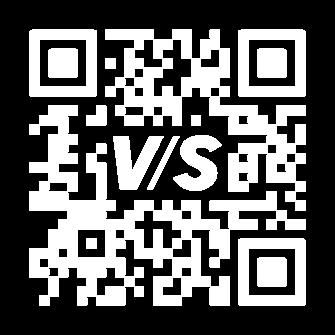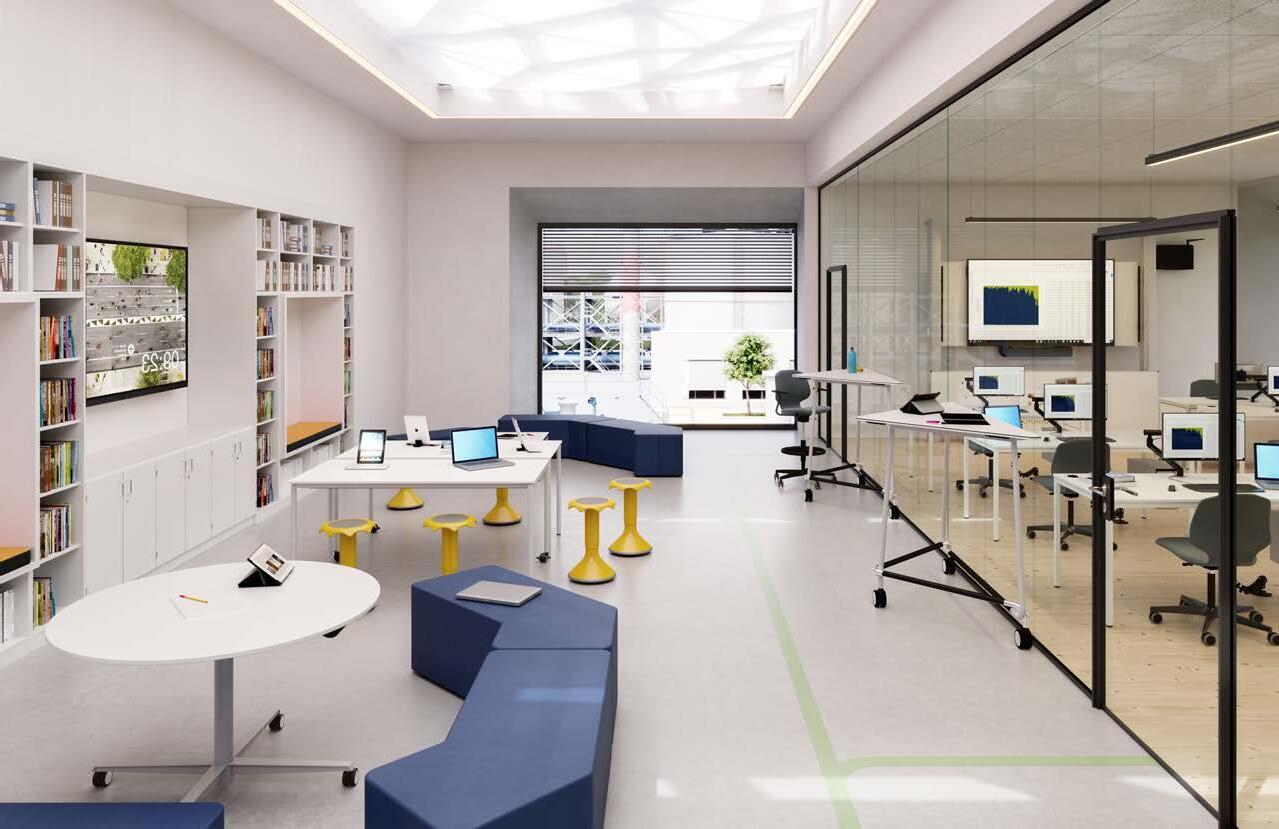

CTE
Career and Technical Education, Innovation Centers, STEM
CTE programs build connections between academic coursework and real-world application. They create opportunities for hands-on learning and provide some of the most meaningful elements of career exploration.
OVERVIEW
Empowering Hands-On Learning
“The flexibility of a learning environment is directly proportional to the creativity it fosters.”
– International Journal of STEM Education
Overview
In the realm of Career and Technical Education (CTE), the shift towards a team-based, projectoriented approach marks a significant stride in aligning educational practices with real-world demands. This approach emphasizes the critical importance of hands-on experiences where students engage in solving authentic problems, mirroring the complexities they will encounter in their future careers.
A study by the Journal of STEM Education highlights that “students engaged in project-based learning demonstrate improved problem-solving skills and a better understanding of complex concepts.” This method prepares students for technical proficiency and cultivates essential soft skills like critical thinking and adaptability.
Team-based, project-oriented approaches supported by flexible classroom designs are transforming CTE. Agile furniture plays a pivotal role in creating adaptive learning environments that cater to the dynamic nature of CTE. A study published in the International Journal of STEM Education found that “classrooms equipped with movable furniture increased student engagement and collaboration, directly impacting learning outcomes.”
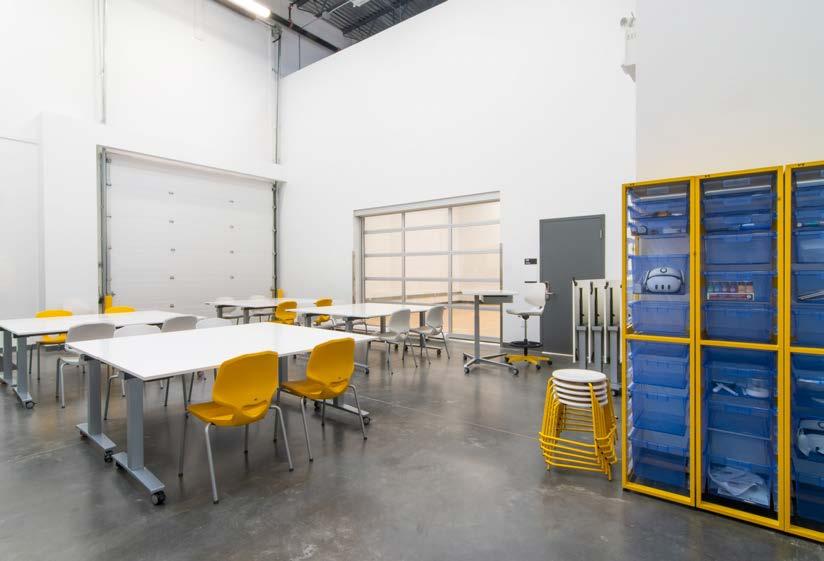
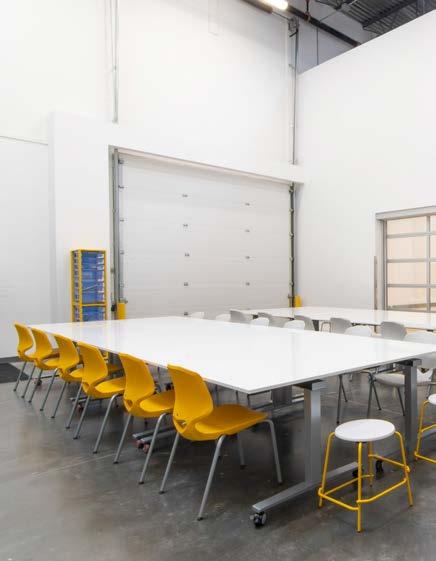
The Role of Flexible Furniture in CTE
In the evolving landscape of CTE, the design of the physical learning environment plays a crucial role in enhancing collaborative work. Educators can select and arrange agile furniture to create workspaces that are not only conducive to teamwork but also inspire complex project execution. The focus is on creating an environment that fosters group interaction and flexibility – essential components in today’s team-oriented educational settings.
Agile furniture in CTE classrooms goes beyond mere aesthetics. As a study in the Journal of Science Education and Technology states, “The physical classroom environment significantly influences students’ collaboration and engagement in STEM activities.” This underscores the need for furniture that is adaptable and can be reconfigured
to suit various learning and teaching styles.
Creating Collaborative Spaces
When selecting furniture, consider pieces that promote interaction and can be easily moved or reconfigured.
• Modular workstations that can be easily rearranged for different group sizes.
• Whiteboard tables for brainstorming and problem solving.
• Rolling chairs and stools for easy movement between collaborative stations.
By combining research-backed insights with practical activities, educators can transform their spaces into dynamic, collaborative environments, enhancing the learning experience.
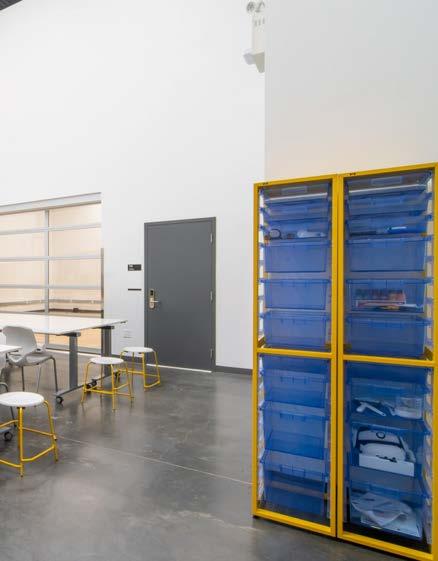
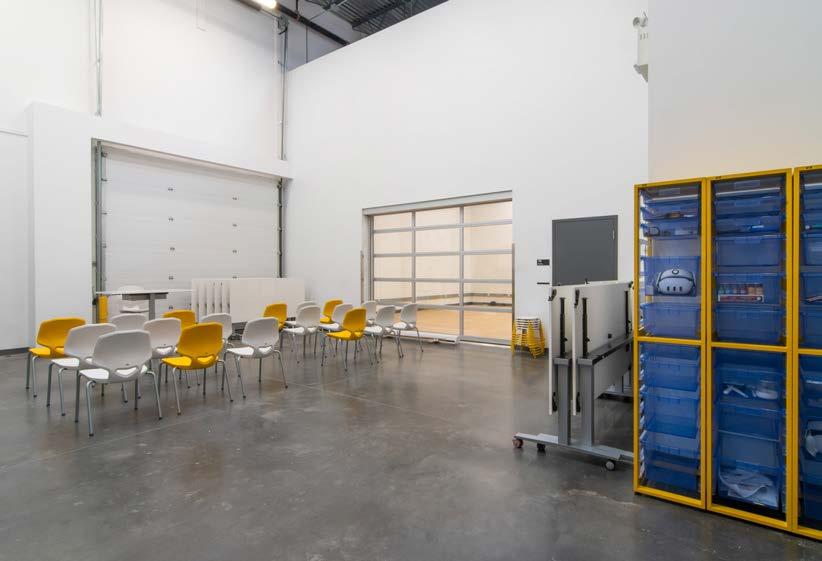
“The design of learning spaces should reflect the collaborative and ever-changing nature of STEM fields.”
– International Journal of Design Education
Crafting Real-World Projects
In CTE, the emphasis on real-world, practical experiences is paramount. Real-world projects are not just learning activities, they also are simulations of actual industry challenges. Educators design and implement industry-relevant projects that engage students in authentic, collaborative problem solving. It’s about connecting classroom learning with the realities of the workforce, preparing students for future careers through hands-on experience.
According to a study in the Journal of Vocational Education & Training, “Effective CTE programs
replicate the complexities of real-world tasks, providing students with experiences that mirror workplace challenges.”
Developing Industry-Relevant Projects
• Educators partner with local businesses or industry professionals and identify current challenges in the field.
• Students are grouped into teams to develop practical solutions to these challenges.
• Projects are then presented to industry professionals for feedback and evaluation.
Building Effective Teams
The art of team building is a cornerstone for project success. Educators can foster effective teamwork through strategic group formation and the deliberate choice of classroom furniture that encourages collaboration.
Effective team building involves more than grouping students, it’s about understanding and leveraging individual strengths and learning styles. A Journal of Technology Education article emphasizes, “In CTE, team building is about creating groups where diverse
skills are harmonized for collaborative success.”
Creating Collaborative Teams
• Students fill out a survey identifying their strengths, weaknesses, and preferences.
• Educators use this data to create balanced teams, ensuring a mix of skills and perspectives.
• Teams discuss their collective strengths and areas for growth, fostering a sense of unity and purpose.
PHOTO: LINCOLN BARBOUR
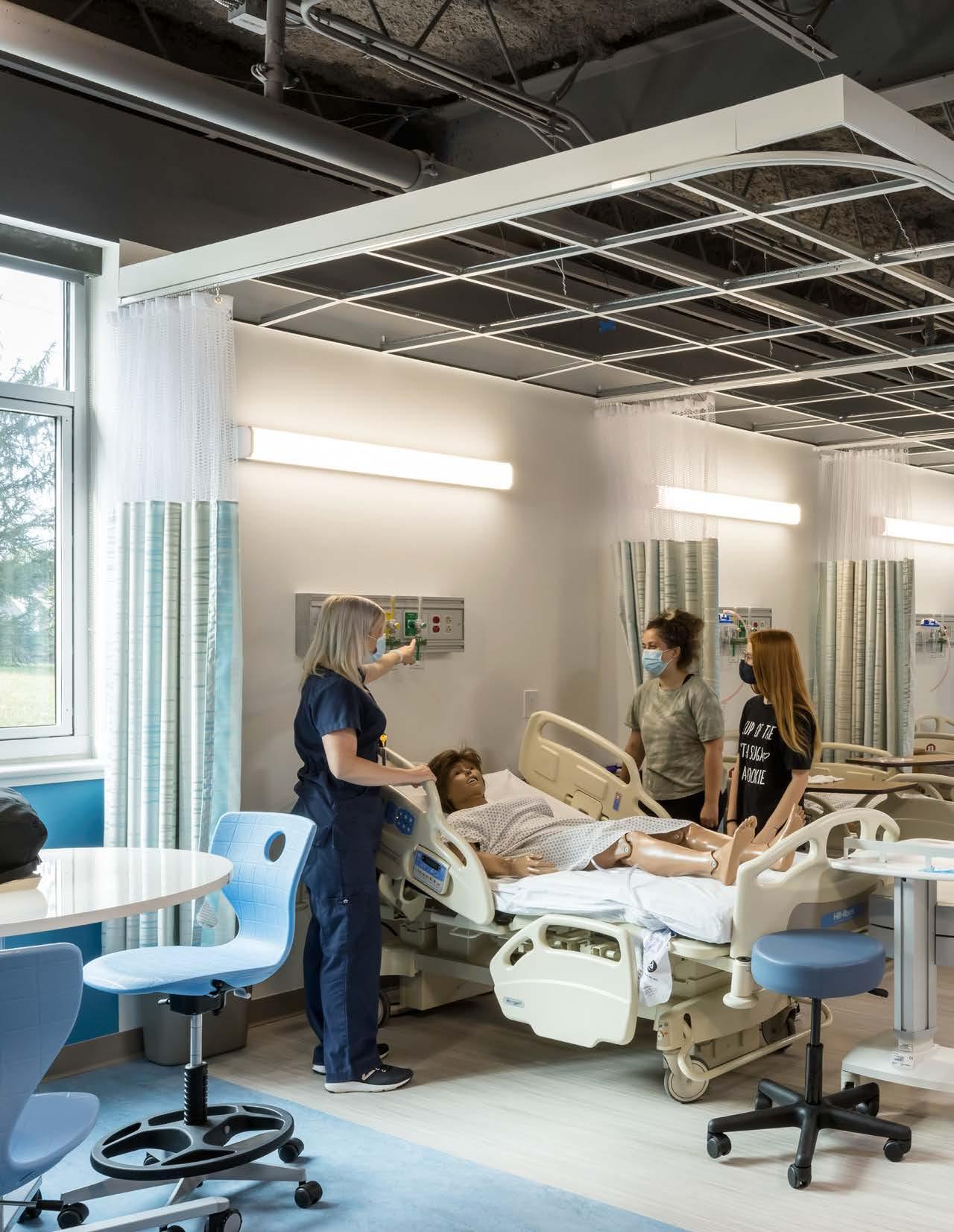
“Furniture arrangement can transform a classroom into a dynamic space for team-based learning.”
– International Journal of Educational Management
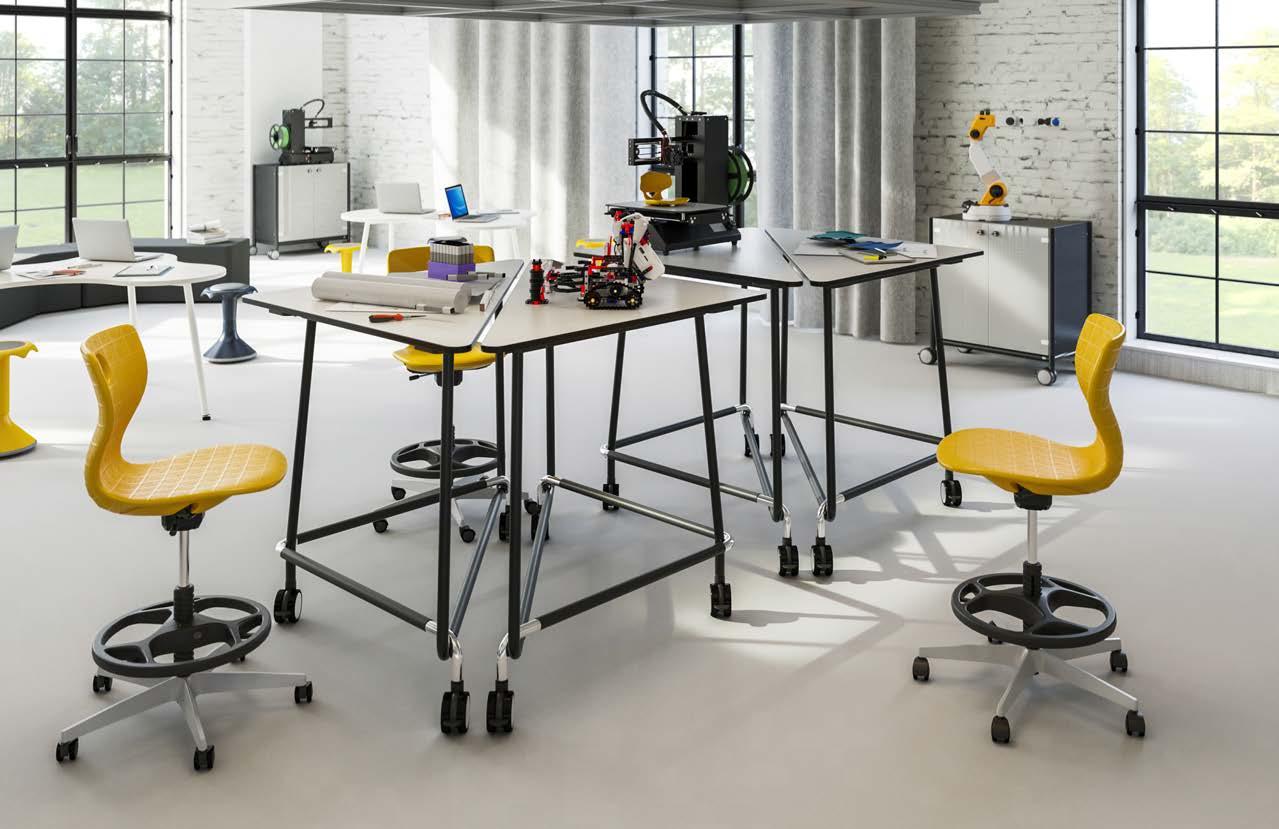
Enhancing Team Collaboration through Furniture
Choosing the right furniture is pivotal in creating an environment conducive to teamwork. VS America offers versatile table and seating options that facilitate face-to-face interaction and flexible group dynamics.
Designing Collaborative Spaces
• Teams analyze their current classroom setup and identify limitations in promoting collaboration.
• Using a digital layout tool, they redesign the space to better facilitate teamwork.
• Teams share their redesigned layouts, highlighting how their choices enhance collaborative learning.
By equipping educators with the right tools and strategies to design a classroom environment that nurtures effective team collaboration and real-world problem solving, CTE classrooms can become more interactive and engaging, setting students up for their future career paths.
“If
we can help educate and give people the chance to make good wages, and also give back to the community while we’re doing it, what bigger win can there be?
“
– Jimmy Robertson Coordinator of Innovation, Career and Technical Education and Business Partnerships, Winchester Public Schools
CASE STUDY
Emil & Grace Shihadeh Innovation Center
Location: Winchester, VA | Completion: 2021 | Architect: VMDO
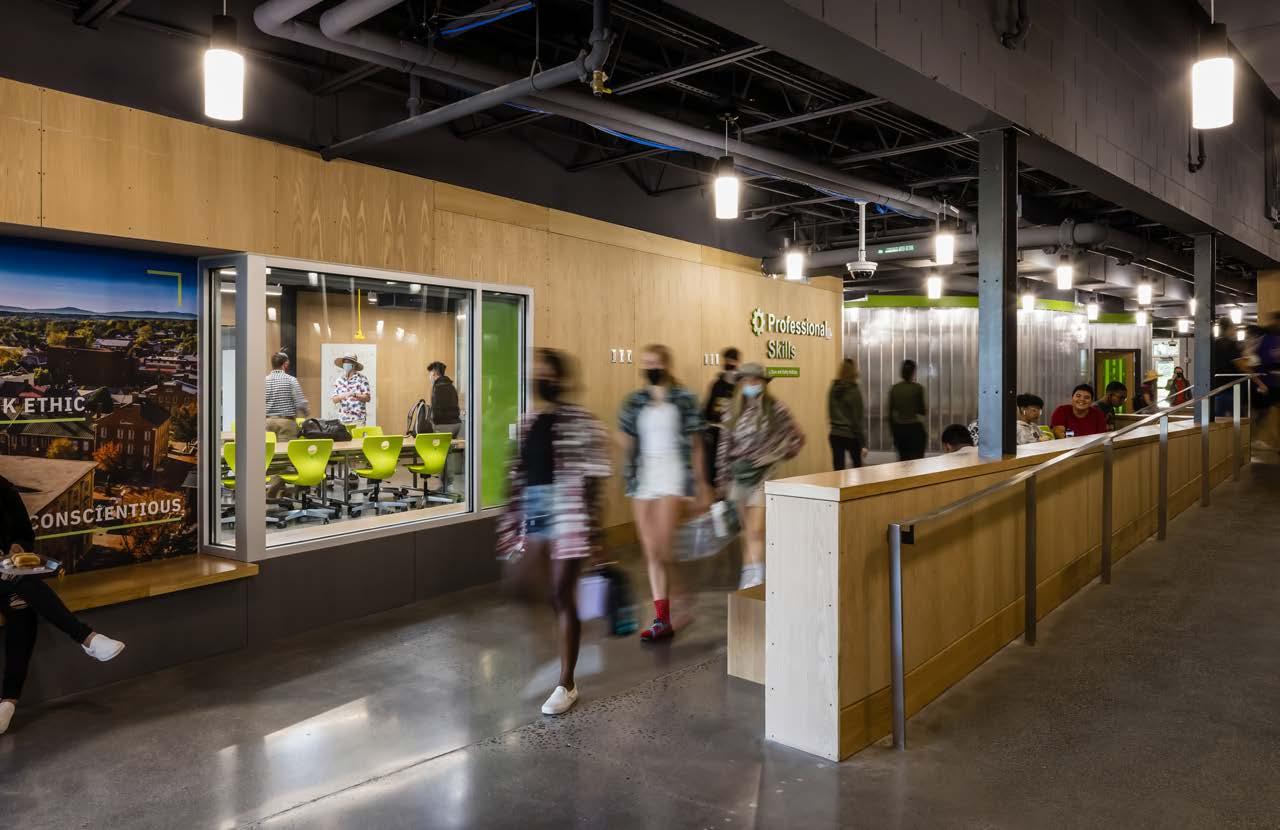
A joint venture with Laurel Ridge Community College and local industry partners, the 54,000-square-foot Shihadeh Innovation Center is a hub of workforce development for the community – preparing both Winchester high school students and community members to meet the demands of the regional job market.
PHOTOS:
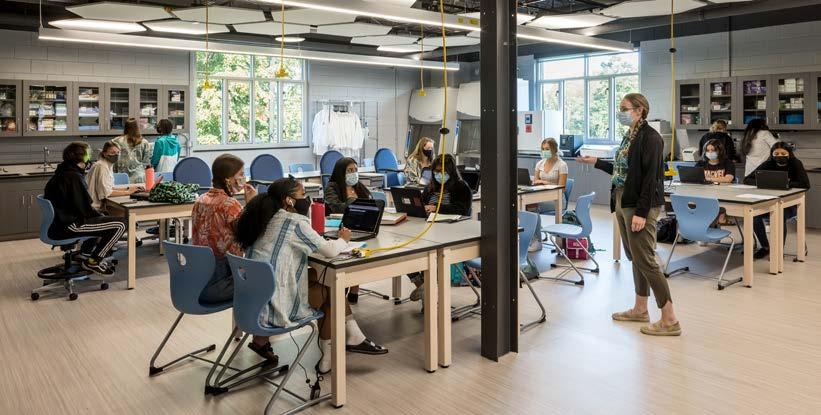
The average age of skilled workers is 56 years old, and by 2025, there will be a 10 million job shortfall in the skilled labor market in the U.S. Rising to meet these challenges, the new Emil + Grace Shihadeh Innovation Center will prepare Winchester Public Schools students and community members for the new workforce of tomorrow. The project is a product of multiple funding sources, including private donations, grants, and an unprecedented amount of state funding. A radical transformation of an existing unused elementary school, the mission of the Center is to ensure that every student is prepared and empowered with a marketable skill that leads to full, high-paying employment and that every regional industry is fully supplied with dedicated, skilled workers who will sustain and improve their business model.
Industry partners play an active role in the development of the program of study, while also committing to work-based learning opportunities for students. Laurel Ridge Community College
provides instructors and equipment for certification and credit-bearing courses.
The Center embodies Winchester Public School’s motto of “Learning for all, whatever it takes.” The culture at the Innovation Center is interdisciplinary and organized into industry themes where CTE teachers, academic teachers, and students work together on real-world problems. All John Handley High School students have the opportunity to apply their academic knowledge to practical skills at the Innovation Center while adults and professionals can learn a new trade to re-enter the workforce or mentor youth interested in their professional field.
The Innovation Center is organized around three academies – Professional Skills Academy, Health Sciences Academy, and Advanced Technologies Academy – that each offer programs that will equip students with the skills and credentials needed for their future careers.
“We connect Career Technical Education with core academic education - there is truly innovative learning happening in this building.”
– Dr. Jason Van Heukelum Superintendent
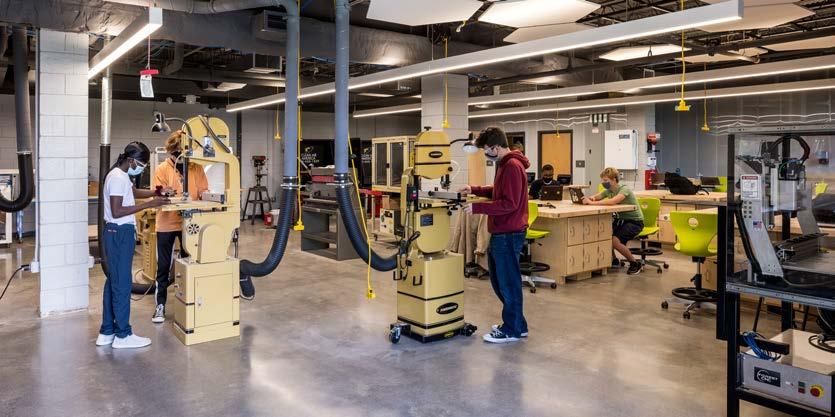

PHOTOS: LINCOLN BARBOUR
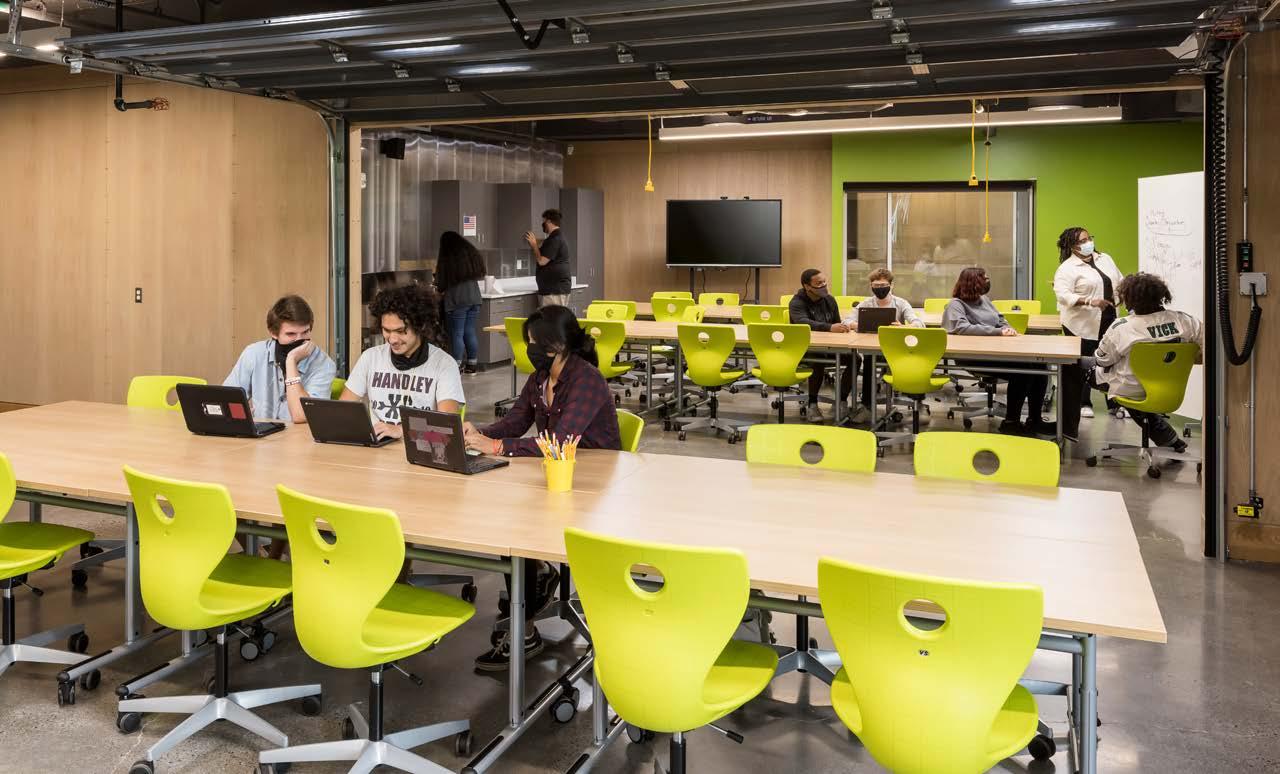
Designed by VMDO and partners Reader + Swartz Architects, the building houses CTE classes currently offered at Handley High School, featuring high-intensity trades and professional skills labs, a health sciences suite, and STEAM lab spaces that support cybersecurity, digital design, robotics, and computer technology. The VS furniture solutions used throughout the innovation center contribute to visibility and open spaces, supporting interdisciplinary interaction and enhancing the architectural vision of the center’s open plan. High-visibility work labs, dynamic collaboration and presentation spaces, abundant natural daylighting, healthy material and air quality, and reduced energy use were all major design drivers.
As all learning is fundamentally social, students must learn to collaborate, laying an important foundation for communication — an essential prerequisite for students to practice critical thinking and creative innovation, which ultimately helps develop the confidence to take risks and iterate on failures.
To do this, civic learning needs to be part and parcel of the current movement across many schools in America to equip young people with 21st-century skills. Advances in the science of learning have bolstered the 21st-century skills movement. Learning scientists offer that young people master math, reading, and science much better if they have an educational experience that develops their social and emotional learning competencies — like self-awareness and relationship skills, which are the foundation of later workplace skills — and puts academic learning in a larger, more meaningful context.
Alongside academic competencies, these students have support spaces to spearhead small group projects and collaborative work. Universal design principles were used to make all spaces accessible, and corridors were purposed for independent learning and collaboration while making programming visible. The Community Cafe is a choice touchdown space for independent learning and sharing a meal.
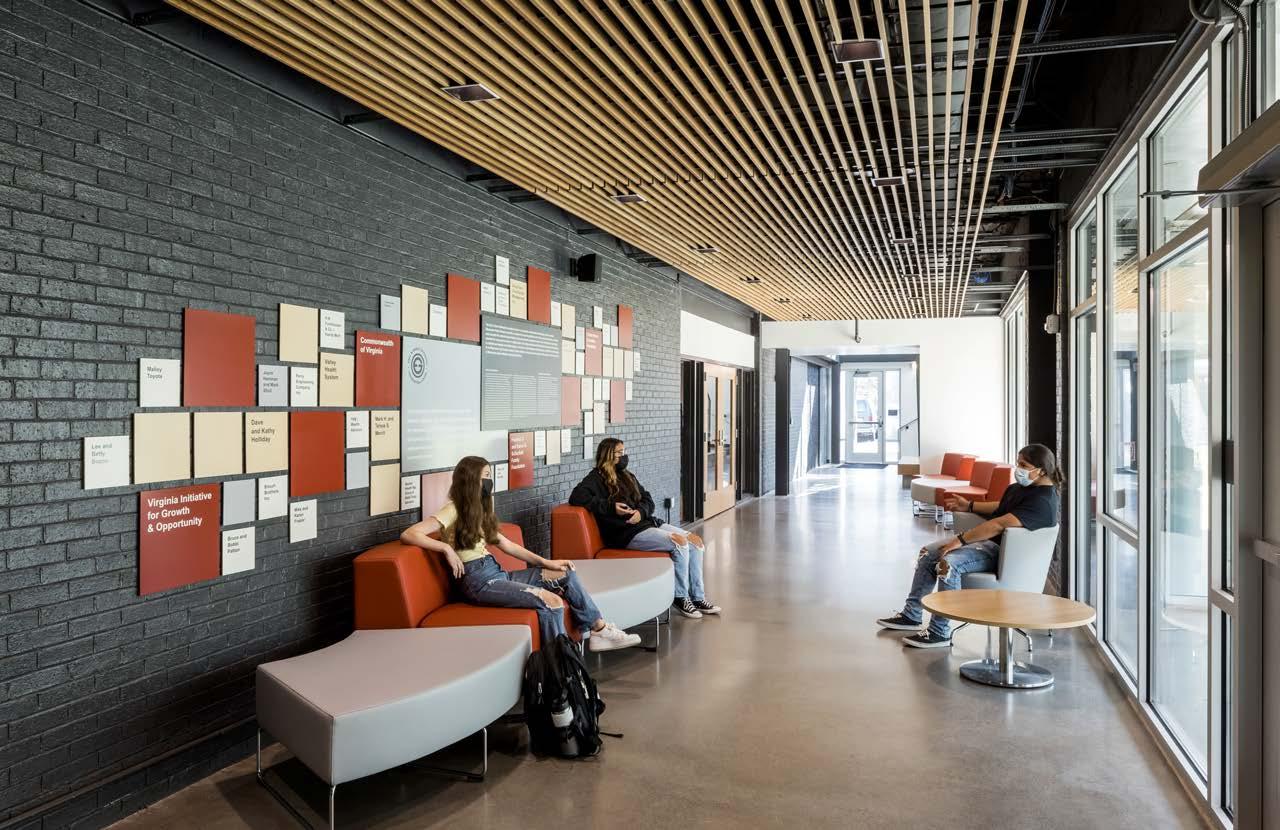
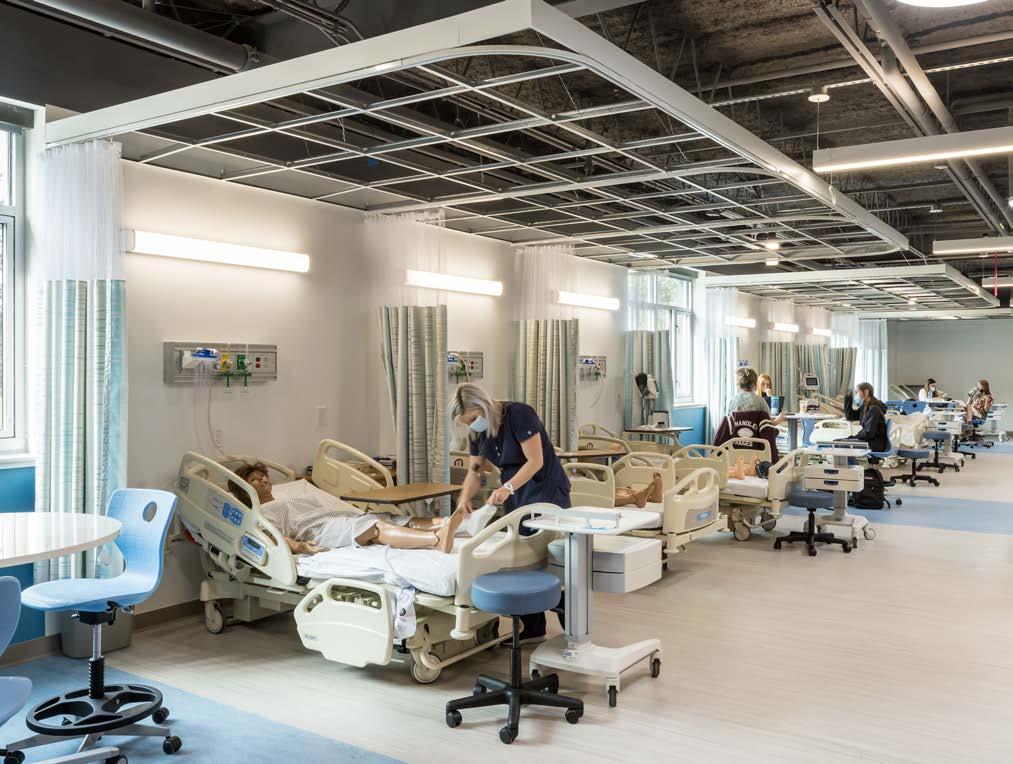
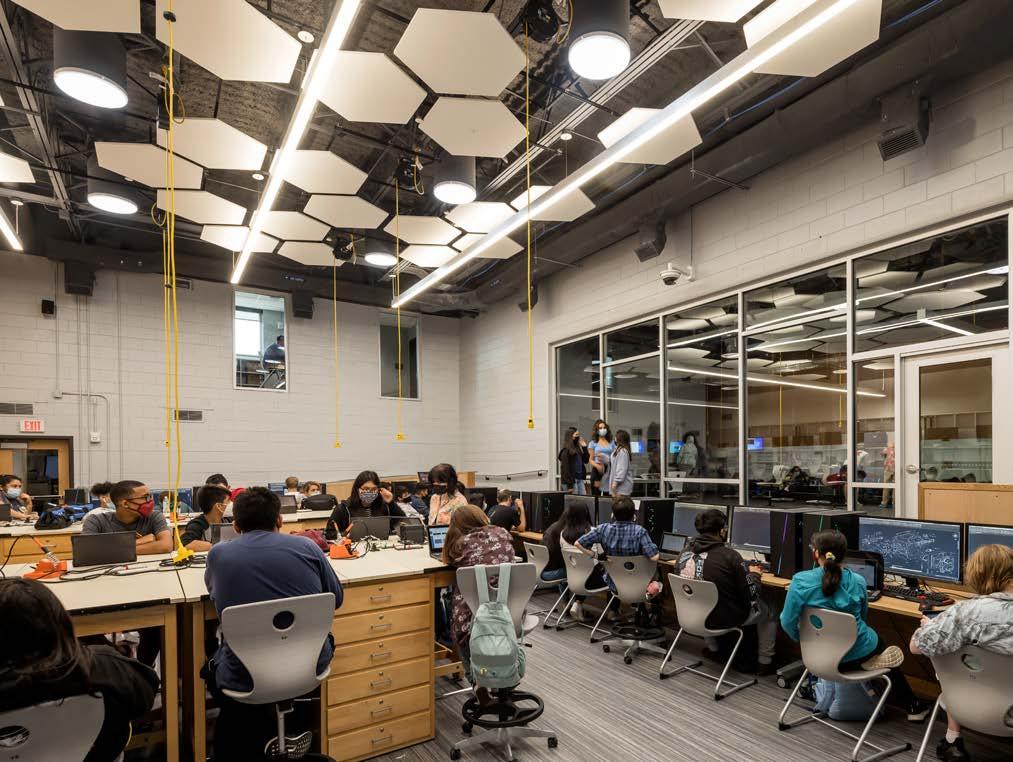
PHOTOS:
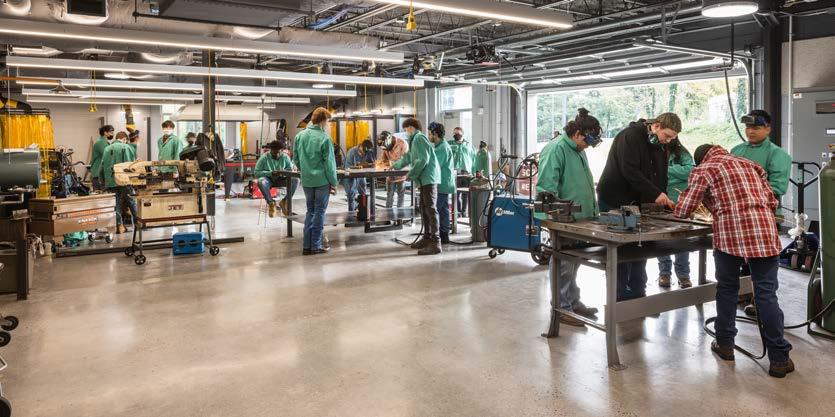
Professional Skills Academy
The Professional Skills Academy addresses the skills gap in our workforce by equipping students with technical skills and training in state-of-the-art lab spaces that support hands-on, real-world projects. Maker Foundations, Welding, and Carpentry Labs include equipment and tools to support hands-on training in materials assembly and construction techniques. Adjacent shared classrooms are utilized for lessons on safety, compliance, and technical content. In addition, flexible lab spaces furnished with agile furniture accommodate instruction in Plumbing, Mechanical, and Electrical trades, as well as evening community classes and industry partnerships, supporting both student and adult learners.
Health Sciences Academy
Students within the Health Sciences Academy gain skills and knowledge in lab spaces that emulate real-world settings. The Health Sciences Academy provides students with a foundation for postsecondary education or workforce readiness in certified health-related professions. Students explore core content with technology through integrated projects, case studies, and focused learning experiences.
Highly specialized equipment, professionally planned lab spaces, and flexible and durable furniture enable students to practice in a clinical laboratory setting while still being in a safe and supervised learning environment. The Nursing Lab
emulates a real-world hospital environment with state-of-the-art equipment donated by community partners. Adjacent Simulation Labs and an ambulance pad allow for supervised emergency scenario simulations and testing.
Advanced Technologies Academy
The mission of the Advanced Technologies Academy is to keep pace with innovation to prepare and empower students for careers in high-tech. The Architectural / Engineering Drafting Lab supports a vibrant program of design and fabrication. Shared 3D printers and plotters located on the adjacent mezzanine make fabrications visible to all students, and the Computer Tech Lab is nearby through the original stage opening. These spaces are enhanced with furniture designed to simplify collaboration and support teamwork.
To complement the academic programs of Handley High School, the Innovation Center is infused with flexible, technologically advanced spaces that support discovery and experimentation. Together, John Handley High School and the Innovation Center provide academic programming and handson learning opportunities that support architectural design, engineering, cybersecurity, computer networking, and systems technology.
This collaboration and innovation better equip students with the skills commonly in demand in the workforce and provide students with real-world technical resources.
Inspiration
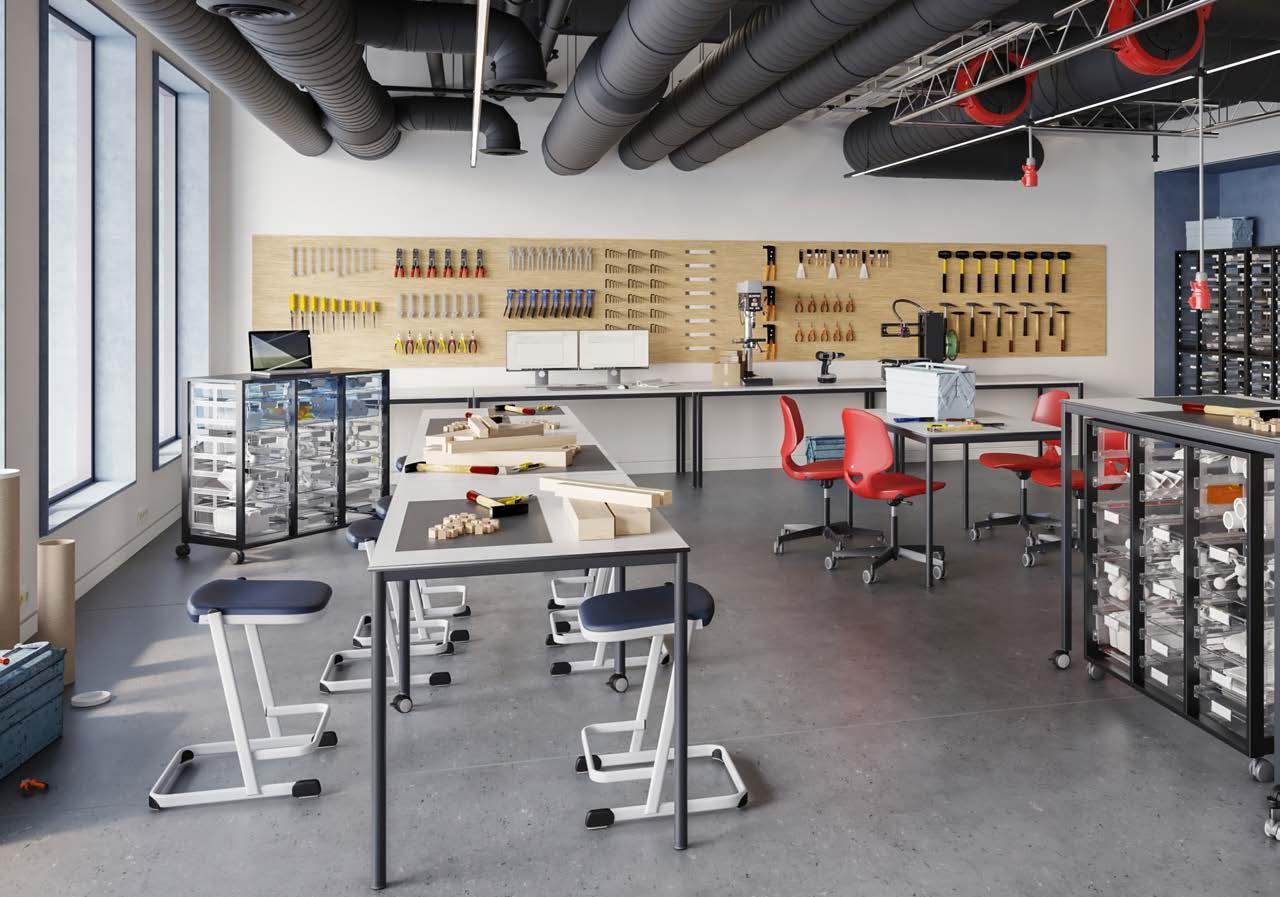
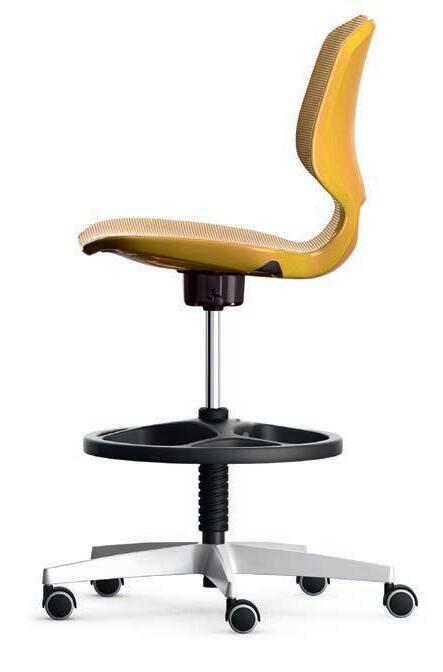
The JUMPER® Air Move has a patented 3D rocking mechanism for even greater dynamic sitting, and its continuous height adjustability means it can easily be used by students of all heights.
45417 + 45436
SpaceStation Storage system.
GREENGUARD BIFMA Level 3
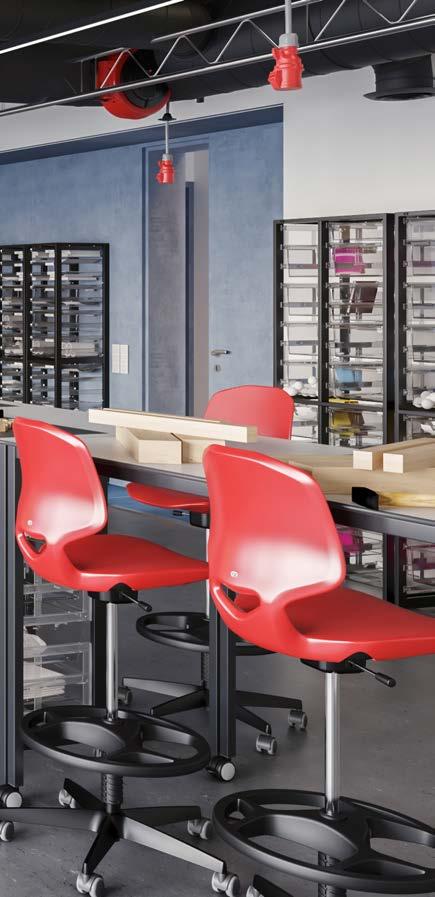
WORK-BASED LEARNING
Work-based learning integrates academic learning with practical, real-world experience to prepare students for future careers. By aligning classroom instruction with hands-on activities, students gain a deeper understanding of their chosen fields and develop essential technical and employability skills.
Partnerships with local businesses provide opportunities for internships, apprenticeships, and real-world projects, enabling students to apply theoretical knowledge in practical settings. This experiential learning enhances technical proficiency and cultivates critical thinking, adaptability, and collaboration skills, all vital for success in today’s dynamic job market.
Planning Tip: Designate collaborative areas with large tables, comfortable seating, and writable surfaces like whiteboards or glass boards. These spaces should encourage group discussions, brainstorming, and teamwork, fostering peer interaction and developing essential communication and collaboration skills.
EcoTable-R Table with round legs.
square
Height-adjustable stool.
45412
SpaceWalk Mobile storage. 33506
JUMPER Air Move
Height-adjustable swivel chair.
Air Move Plus
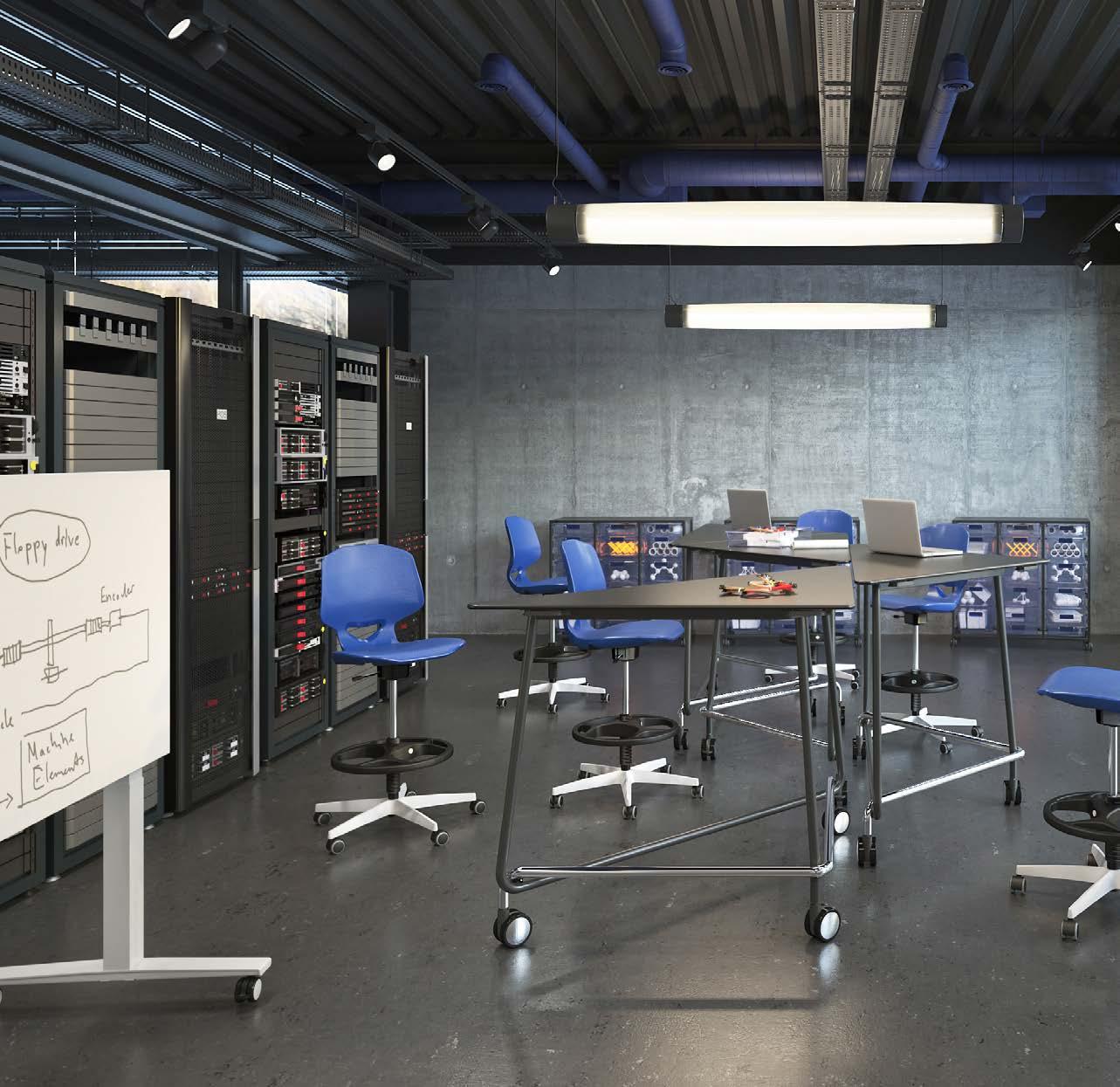
LiteTable-ST Stackable table.
TriUnion Stand-at table.
SpaceWalk Mobile storage.
JUMPER Air Move Plus Height-adjustable stool.
JUMPER Air Active Forward-flexing cantilever chair.
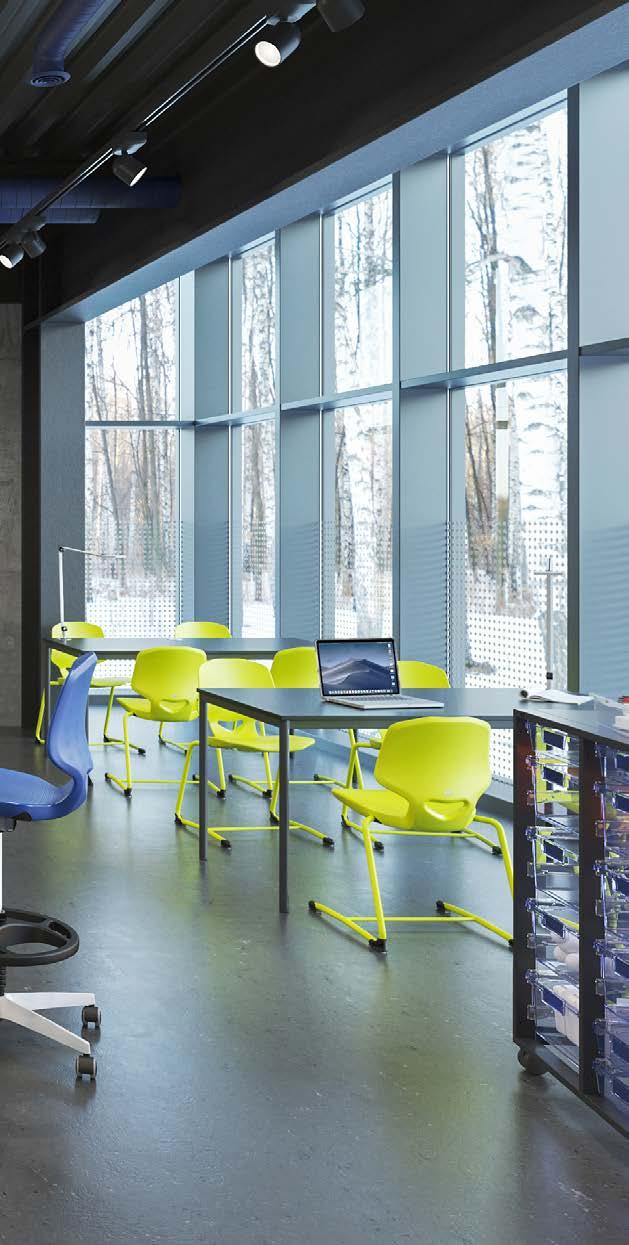
WORK-BASED LEARNING
Work-based learning programs provide students with mentorship and feedback from industry professionals, bridging the gap between education and employment. Mentors offer guidance, share industry insights, and help students navigate the complexities of their future careers, ensuring a smoother transition from school to the workforce. This comprehensive approach to learning fosters a deeper engagement with the subject matter and promotes a culture of continuous improvement and lifelong learning. By creating versatile, adaptable learning environments equipped with agile furniture and advanced technology, schools and programs can support a wide range of work-based learning activities, ultimately preparing students to thrive in their professional lives.
Planning Tip: Design simulation areas that mimic real-world work environments relevant to students’ fields of study, such as mock healthcare labs, manufacturing floors, or business offices. These spaces provide hands-on experience in a controlled setting, allowing students to practice and refine their skills before entering the workforce.
STUDENT LEADERSHIP
A key purpose of student leadership spaces is to foster personal development, academic learning, and career preparation, supporting overall student growth. Student leadership is transformative as it ignites potential, fosters initiative, and hones problem-solving and decision-making skills. By taking on leadership roles, students lead projects, collaborate, and tackle real-world challenges, building confidence for future careers. These roles instill a deep sense of responsibility and ownership, fueling commitment to their educational and career aspirations
Planning Tip: Design student leadership and apprenticeship spaces with versatile, multipurpose furniture to support a variety of learning and professional development activities. Ensure these spaces align with career pathways and postsecondary education, fostering environments that promote hands-on learning, collaboration, and interactions with industry professionals.
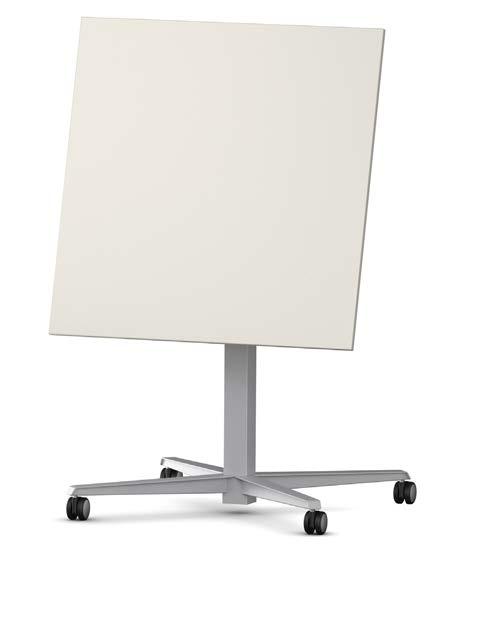
The tilt feature available on certain RondoLift models allows it to be stowed in a snap, shared between rooms, or converted to a projection or display surface.

22237
RondoLift-R Height-adjustable table.
22111
FlipTable-RU
Table with folding top.
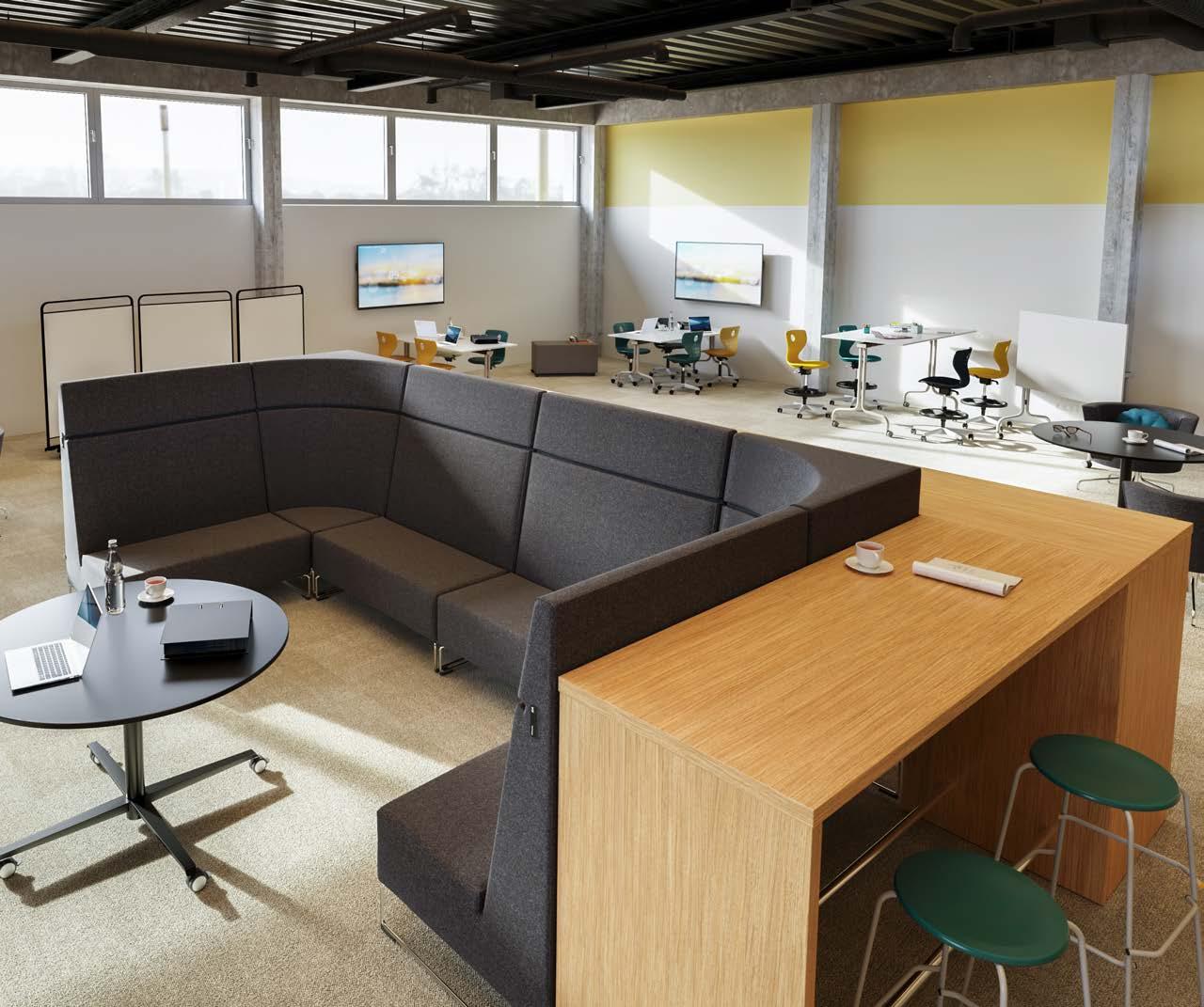
30111 + 30114
Series Lounge HiBack soft seating.
30188
Series Lounge LowBack armchair.
20113
Series Lounge Occasional table. 03826
Solo Stackable stool.
STUDENT LEADERSHIP
Designing spaces for student leadership development involves creating areas that support skill-building activities, leadership training, and professional interactions. These spaces should be an integral part of the program of study, accessible to all students, and regularly used within the instructional framework. Areas for technical and academic skill development, such as study zones, are essential. Additionally, incorporating zones for professional interactions, such as meeting rooms with video conferencing technology, allows students to engage with industry professionals.
Planning Tip: Choose flexible, multipurpose furniture to foster collaboration between students in CTE courses and other subjects. Here, students can engage in interdisciplinary projects, connecting their interests and enhancing their understanding across various subjects.
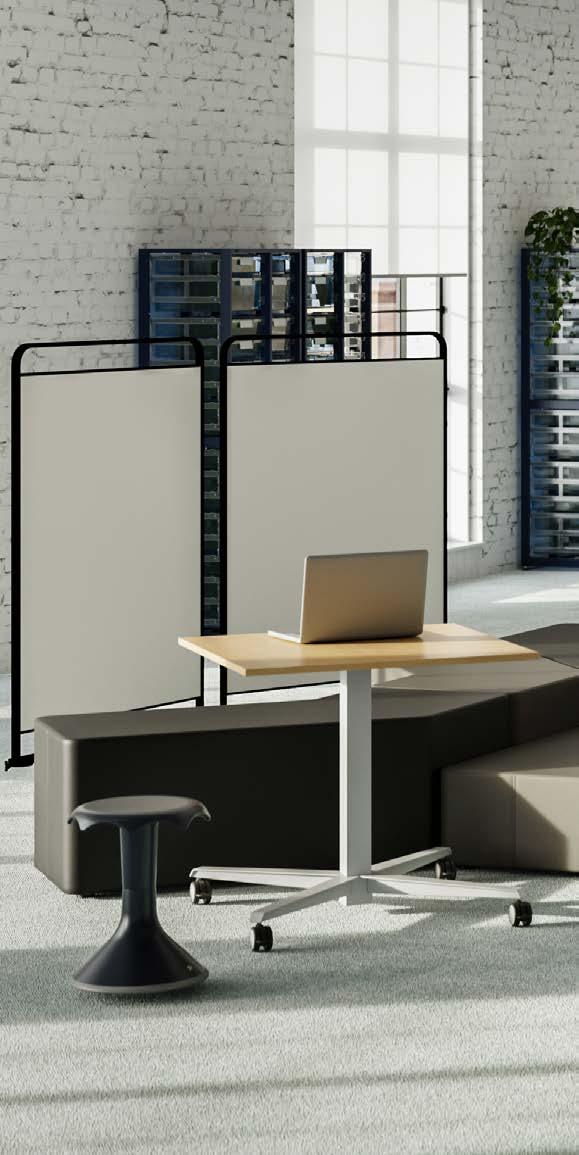
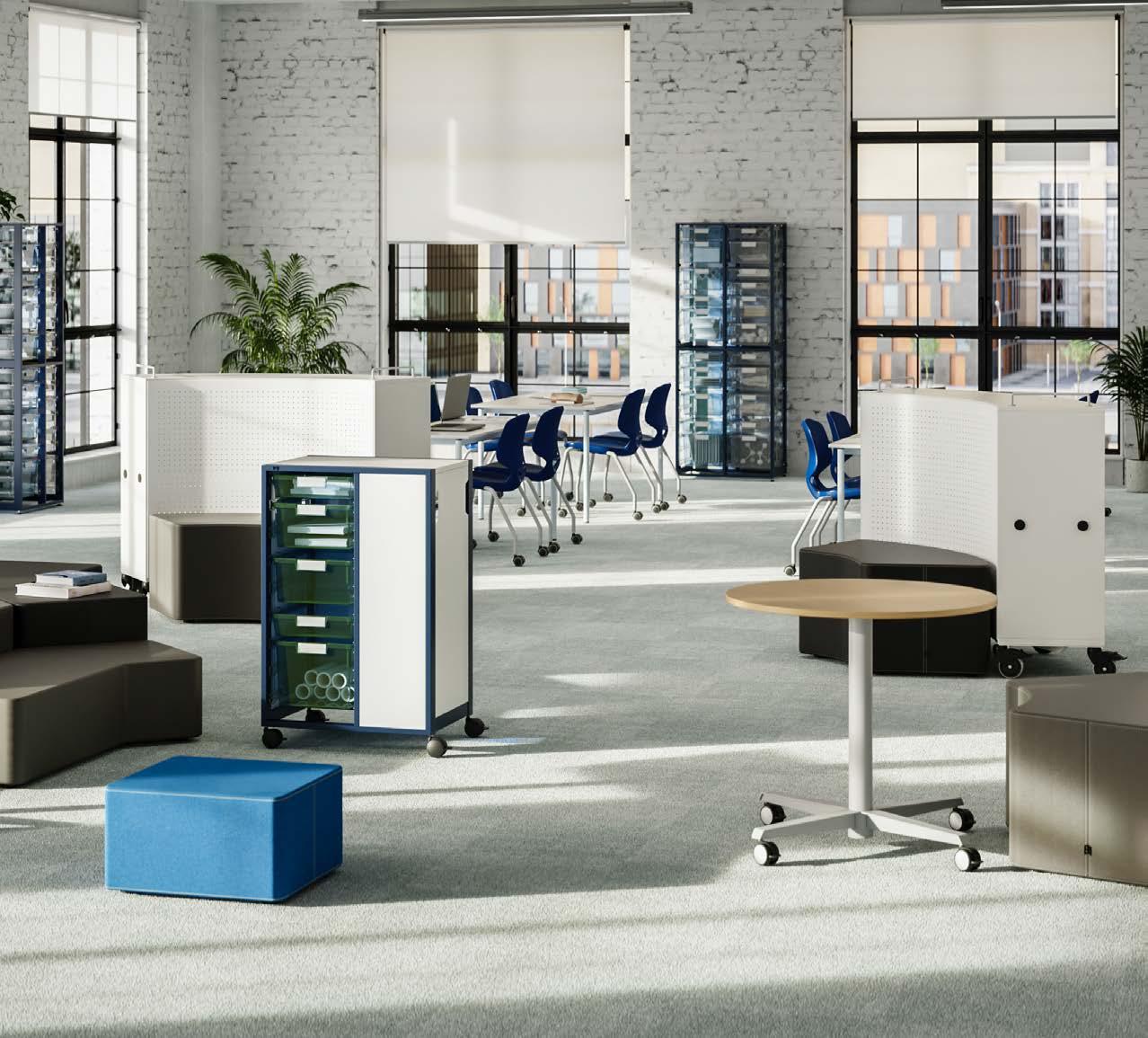
RondoLift-R
09325 + 09329
09326 + 09327
Shift+ Landscape Soft seating. 22237
Height-adjustable table.
05591
LinkUp Mobile partition.
21083
LiteTable-ST Stackable table.
33319
JUMPER Air Four Four-legged chair with castors.
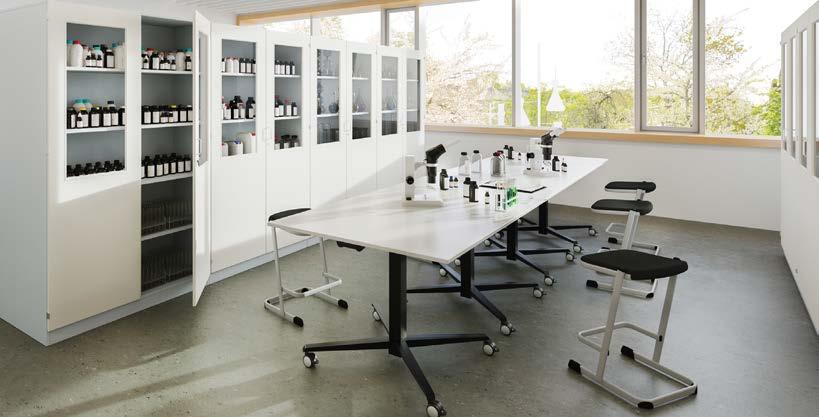
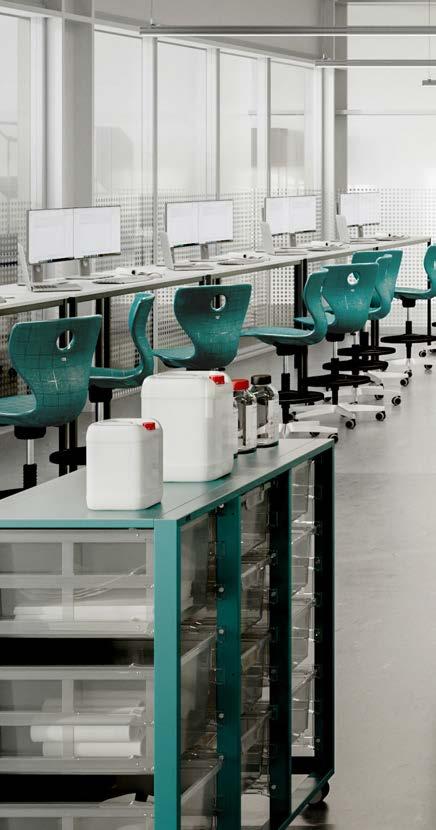
22233
RondoLift-Q Height-adjustable table.
44571
Series 800 Storage system.
45412 SpaceWalk Mobile storage.
A2557
EcoTable-Q Table with square legs.
22111
FlipTable-RU Table with folding top.
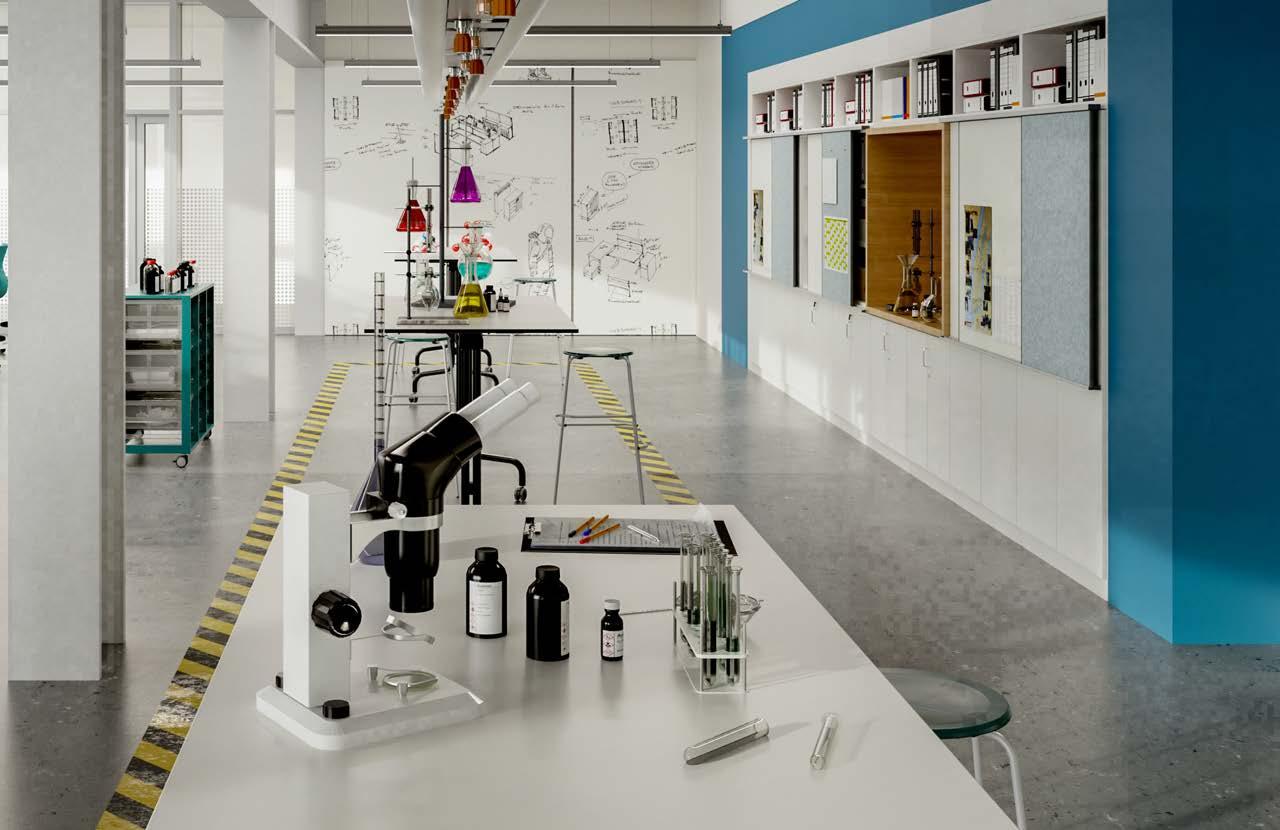
LABORATORY LEARNING
Laboratory learning spaces should align with local labor market needs, ensuring the curriculum prepares students for careers in their community by supporting work that mirrors real-life scenarios. This approach enhances student engagement through projectbased learning and helps build strong business and community partnerships. Sourcing projects from online communities or creating a makerspace within the lab can provide diverse learning experiences, while integrating relevant technologies and equipment into lesson plans ensures students are prepared for modern workplaces.
Planning Tip: The appropriate furniture solutions – such as movable lab benches, adjustable workstations, effective storage, and versatile seating – support the dynamic use of space and allow for quick reconfiguration to accommodate various activities and instructional methods.
CLASSROOM INSTRUCTION
The design of CTE and STEM classrooms is crucial because it directly influences the quality and effectiveness of student learning experiences. These classrooms should be designed to be flexible and adaptable, allowing for easy reconfiguration to accommodate a variety of teaching methods and learning activities. By creating well-organized, adaptable, and resource-rich environments, CTE and STEM classrooms effectively prepare students for the demands of modern careers, equipping them with the skills and knowledge necessary to excel in a rapidly evolving technological landscape.
Planning Tip: Design CTE classrooms with flexible and movable furniture to create versatile zones for group work and individual study, ensuring adaptability to various teaching methods and evolving educational needs.
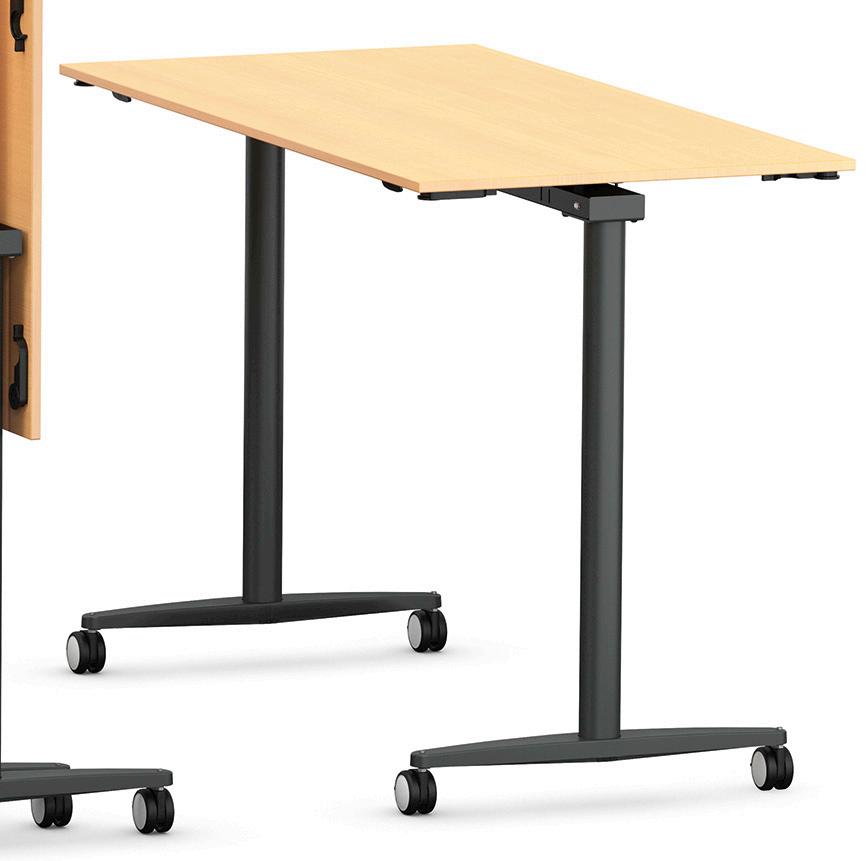
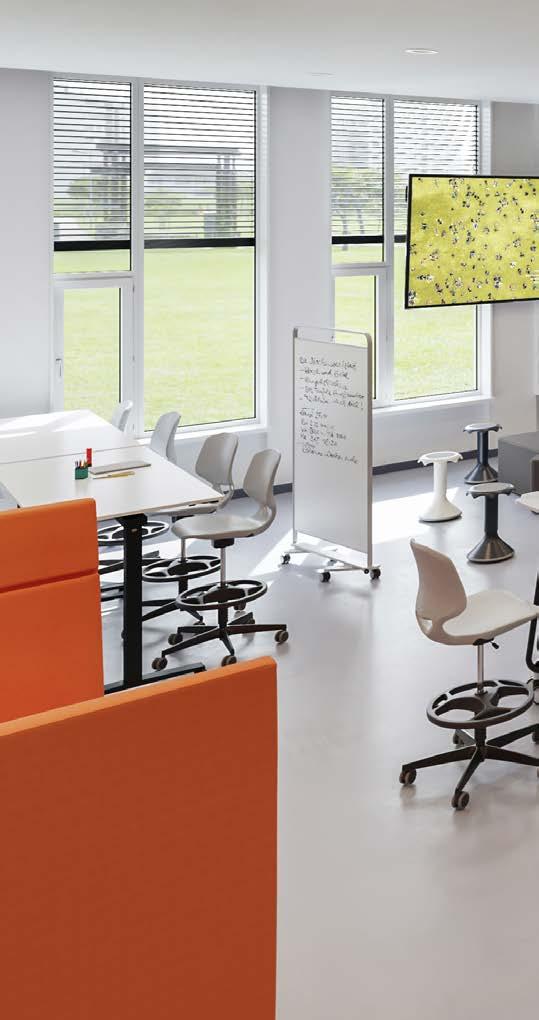
22132
FlipTable-TR Table with folding top.
The FlipTable-TR is a mobile group table designed to easily create large groups for breakout sessions.
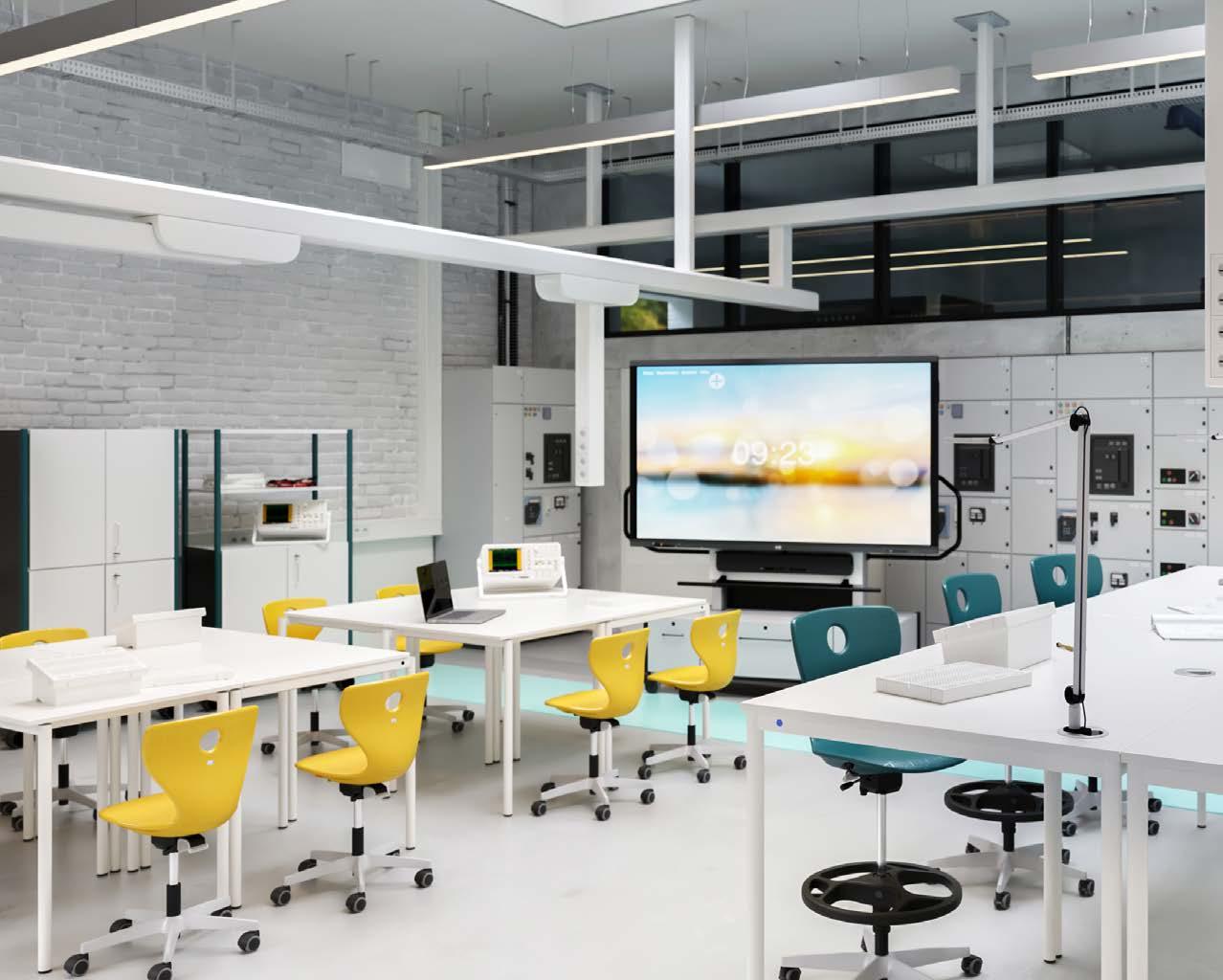
EcoTable-R Table with round legs.
45239
Series 600 Mobile storage. 45231
Series 600 Mobile storage.
LiteTable-ST Stackable table.
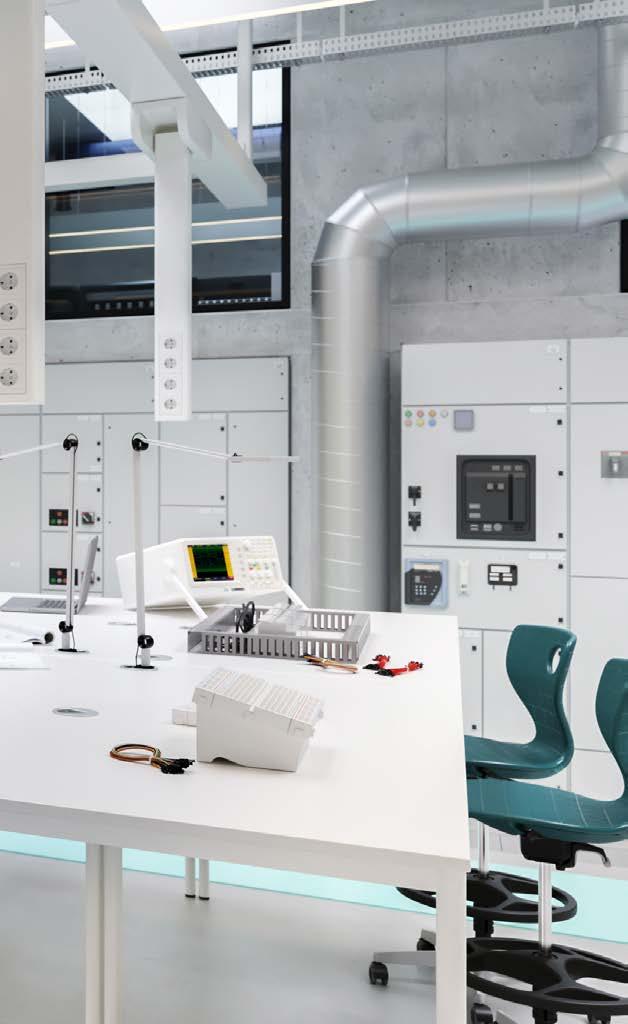
CLASSROOM INSTRUCTION
Versatility is essential in STEM and CTE where practical application of knowledge through projects and experiments is as important as theoretical understanding. Incorporating defined zones for different tasks – such as collaborative workspaces, individual study areas, and simulation labs – ensures that students can easily shift between different modes of learning
Planning Tip: Design classroom environments that blend traditional academic instruction with hands-on technical training using flexible seating, advanced technology, and industry-standard equipment to enhance student engagement and connect theory with practice, preparing students for academic and career success.
CLASSROOM INSTRUCTION
Design CTE classrooms with flexible layouts to support authentic, relevant, and complex work that reflects real-life scenarios. This setup aids CTE teachers in creating adaptable lesson plans by allowing them to present concepts more flexibly and tailor their instruction to meet diverse student needs. Thoughtful classroom design also includes ample storage for tools and materials, ensuring that students have ready access to the resources they need.
Planning Tip: Movable furniture and modular workstations enable seamless transitions between individual study, group projects, and hands-on activities, fostering a dynamic and engaging learning environment.
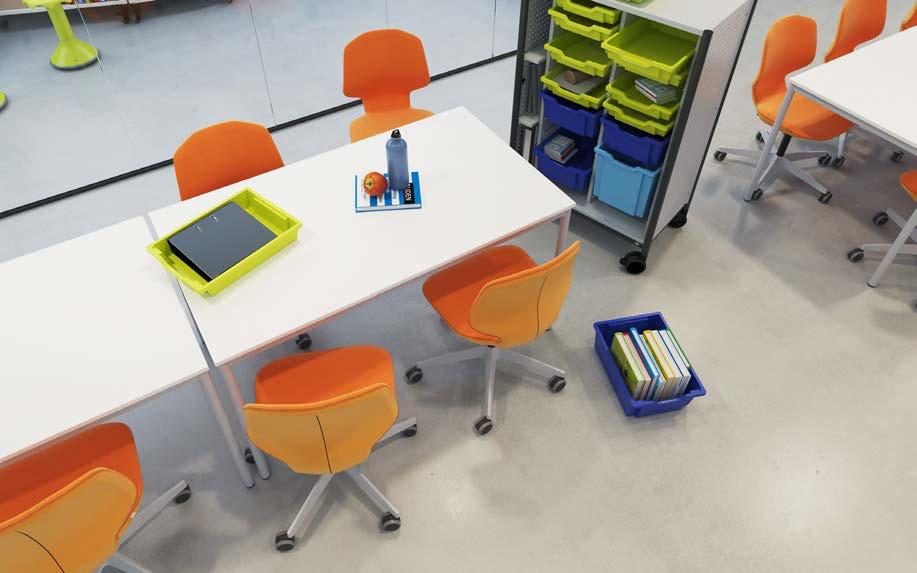
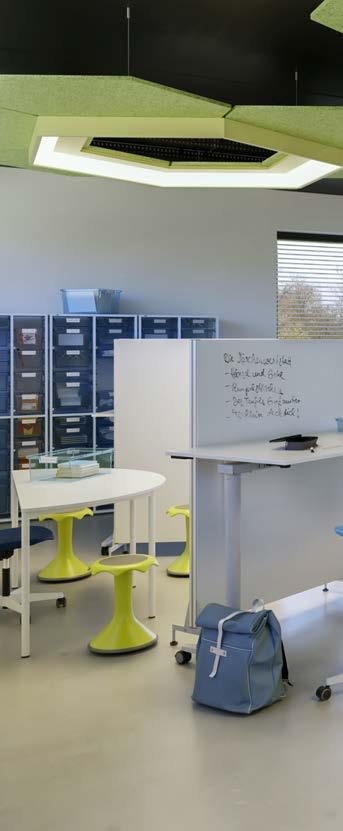
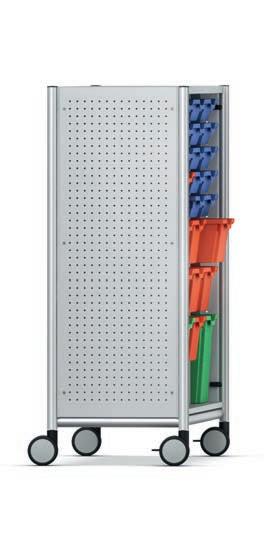
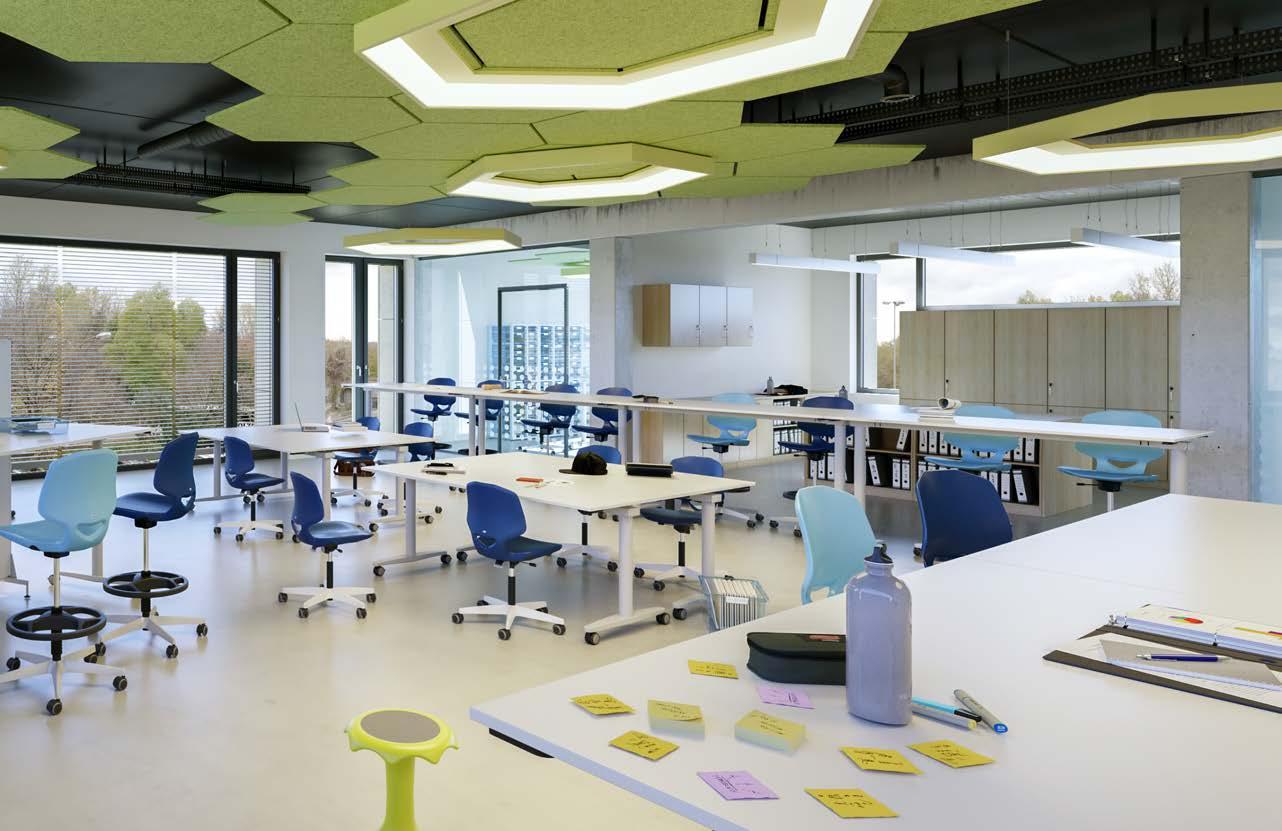
45417 + 45436 SpaceStation Storage system.
05408 Series 2000 Mobile screen.
22132
FlipTable-TR Table with folding top.
45242 Series 600 Mobile storage.
23085
EcoTable-R Table with round legs.
33562
JUMPER Ply Move
Height-adjustable swivel chair.
23088
EcoTable-R Semicircular table.
03825 Hokki Wobble stool.
33506 + 33526
JUMPER Air Move
Height-adjustable swivel chair.
Storage Tables Seating
VS develops the ideas behind our furniture concepts in cooperation with experts from the fields of pedagogy, teaching and school practice, interior design and architecture, trend and behavioral research, and ergonomics. Through their knowledge, our cooperative partners always take us that bit further — so we can provide schools with the exact space concepts they need.
Products
STORAGE
When designing a CTE environment, VS offers an extensive range of modular storage systems, including specialized shelving and mobile cabinets, to enhance flexibility and organization. These systems support various configurations, optimizing space and functionality to accommodate diverse learning activities. In STEM and CTE where authentic hands-on experiences are essential for skill development, adaptable storage solutions are crucial. They must respond quickly to evolving needs, while cutting clutter, improving workflow, and raising visibility.
Our contemporary storage solutions are engineered to meet these demands, accommodating a wide array of tools and materials while aligning with industry standards.
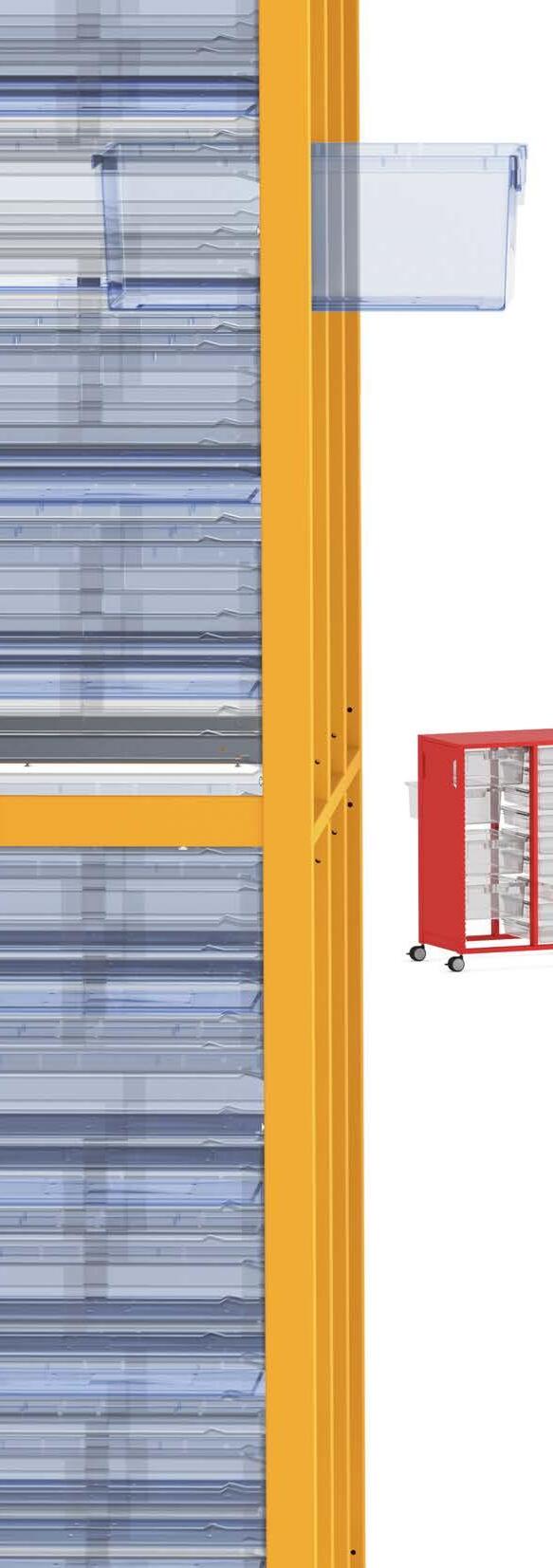
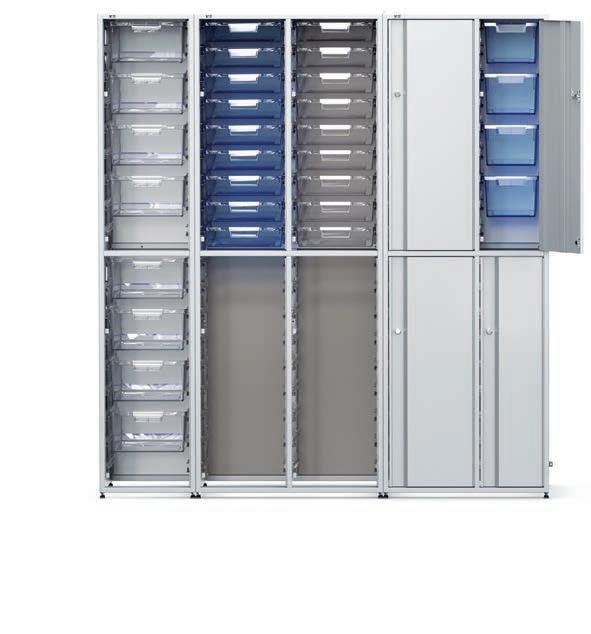
SPACESTATION
SpaceStation elements are high-capacity, fixed steel storage units designed to attach to walls and connect in a series. These units are ideal for organizing shared resource areas throughout the entire school and as storage areas in laboratories, specialized pathway spaces, learning commons, and classrooms. Their versatile design enhances storage efficiency and accessibility, making them a valuable solution for managing materials and resources in CTE and STEM programs, where effective organization is crucial for hands-on learning and technical projects.
Planning Tip: Integrating high-density storage ensures ample and efficient space for tools, equipment, and materials, supporting a well-organized and productive learning environment where hands-on activities and collaborative projects can thrive.
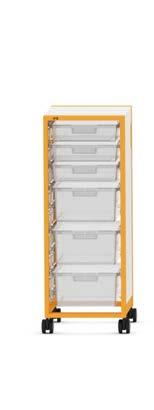
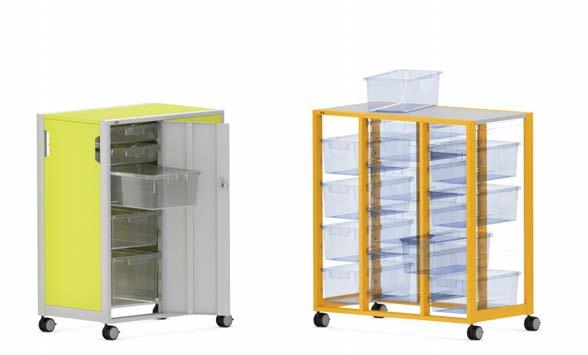
SPACEWALK
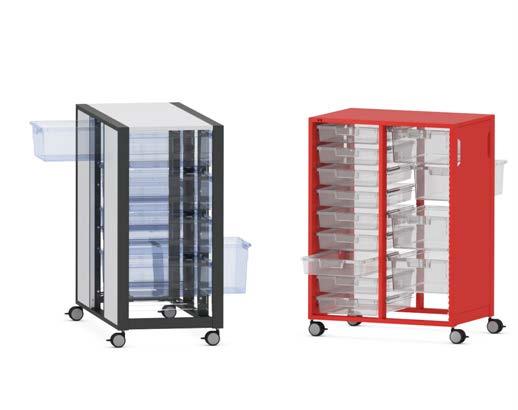
Designed with a bent and fully welded, powdercoated steel tube frame and lockable swivel castors, SpaceWalk rolling carts are engineered to perform and endure the rigors of everyday school life. Options include hinged steel doors with cylinder locks and side panels with easy-grip hand notches, as well as carts without these features for quick visibility of contents. Packed with interchangeable bins, SpaceWalk carts roll the lesson right to where it’s needed. Available in single- and double-sided elements, and with standard bins or VS custom bookbins.
Planning Tip: Use rolling carts to efficiently transport tools, equipment, and materials in CTE and STEM environments. Their mobile design facilitates quick adaptations for various activities, ensuring a wellfunctioning space that supports seamless transitions and effective hands-on learning.
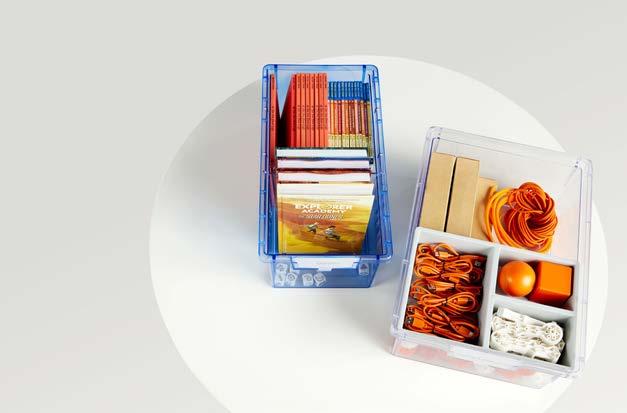
Double-sided elements allow access anywhere in the room.
Optionally with door and lock.
VS’ exclusive bookbin allows for maximum storage from reading to robotics.
Available with castors (two lockable) or adjustable feet.
Magnetic rear panel made from perforated steel.
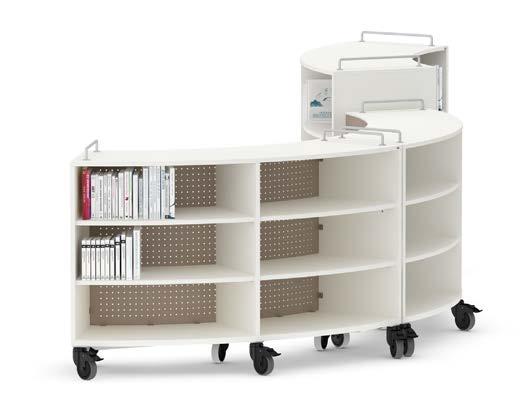
SHIFT+ TRANSFER
Magnets for the secure connection of cabinet elements.
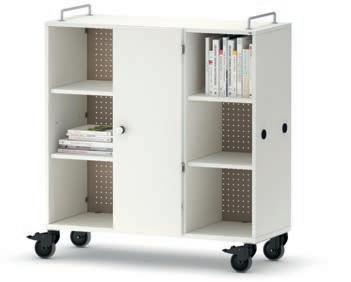
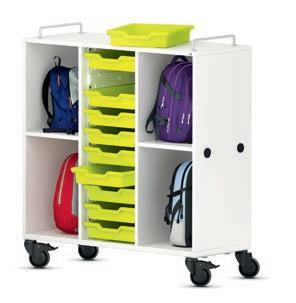
The Transfer mobile elements are available in various heights, and in single- or double-sided options. They can be formed into various combinations and together with the Shift+ seating elements create separated group areas. The mobile shelving elements can also be equipped to accommodate storage boxes, and some models are available with wardrobe hooks.
The Transfer units have bases made from welded steel, providing superior strength and longevity. They also have crossbars across the bottom for exceptional rigidity – ensuring that the shelving elements don’t wobble.
Planning Tip: Utilize storage of various shapes to create versatile and reconfigurable learning environments that seamlessly shift between small group areas, huddle spaces, and various configurations. Integrate considerations for large equipment, safety zones, and specialized systems to ensure the space is functional, safe, and efficient.
Available with guides for storage boxes.
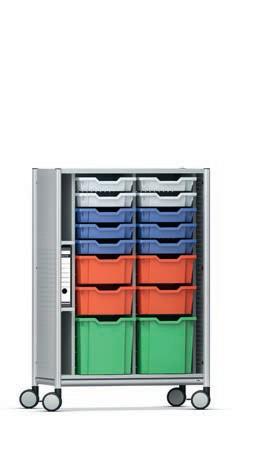
SERIES 600
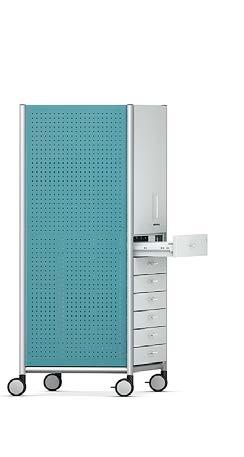
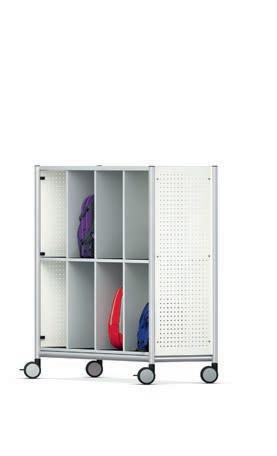
Magnetic side and back panels made from perforated steel.
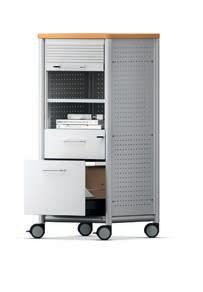
The Series 600 storage line meets the demands of today’s flexible classrooms with its versatile design and range of elements available. Featuring durable tubular steel framing and options for plastic boxes or individual cubbies, these mobile storage modules keep supplies neatly organized. The Series 600 elements can be easily moved around the room, providing adaptable storage solutions that help keep learning spaces tidy and materials readily accessible.
Planning Tip: Use durable mobile metal storage to secure tools and materials, facilitating efficient workflow and adaptability in dynamic, hands-on learning environments, enhancing their functionality.
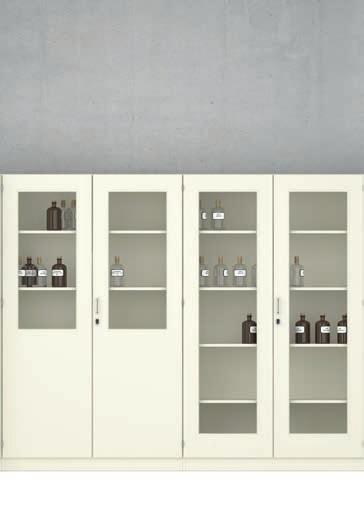
SERIES 800


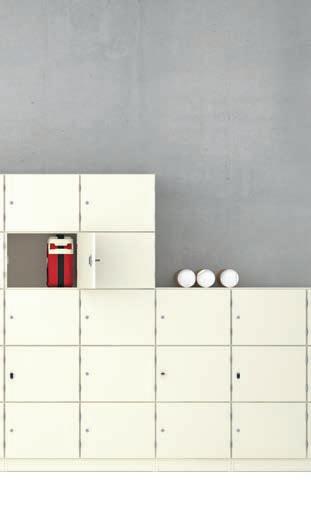
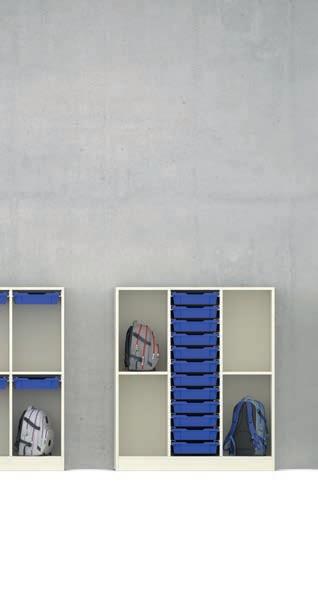
Elevate your learning spaces with Series 800 storage solutions, offering versatile, high-capacity storage that adapts to diverse needs. Its modular design allows for customized configurations, ensuring secure and organized storage for tools, equipment, and materials. Ideal for laboratories, specialized areas, and collaborative spaces, Series 800 units optimize space and boost organization.
Planning Tip: Utilize customizable wall storage solutions in educational spaces for easy organization and access to tools, equipment, and materials. This enhances efficiency and functionality in labs and specialized areas, supporting diverse learning activities.
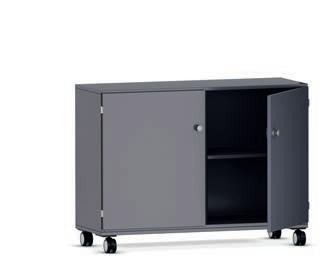
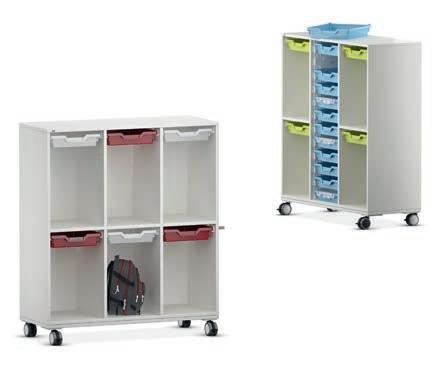
SERIES 800 MOBILE
The Series 800 storage line provides a comprehensive range of mobile cabinets designed for dynamic learning environments. From swing door cabinets and shelving units to specialized backpack cabinets and box storage, these versatile options offer diverse organization possibilities. Easily moved around the room, the Series 800 cabinets support flexible classroom layouts and help keep spaces tidy and efficient, making it easier for teachers and students to access materials and stay organized throughout the day.
Planning Tip: Incorporate mobile storage solutions in skills labs to enhance flexibility and efficiency. These versatile units organize a range of tools and equipment, supporting easy reconfiguration of learning environments for hands-on, cross-disciplinary experiences.
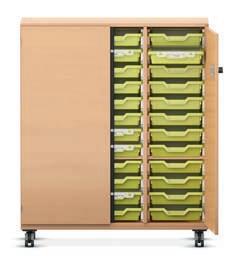
Elements with lockable doors available.
Lockable castors.
TABLES
VS furniture enhances CTE environments with adaptable table solutions designed for a wide range of learning activities and collaborative projects.
Our tables accommodate sitting and standing and various group sizes, essential for hands-on learning in STEM and CTE courses. VS tables can be utilized individually or configured into different formations to align with dynamic educational requirements.
Our table designs prioritize functionality, comfort, and durability, featuring surfaces crafted to endure demanding conditions, including exposure to chemicals. With VS tables, create a robust and engaging environment that fosters innovation and skill development for years to come.
The folding mechanism is operated by 2 hands and ensures the tabletop is never flipped by accident.
Available with phenolic (HPL) tops.
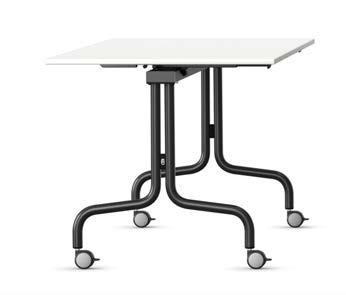
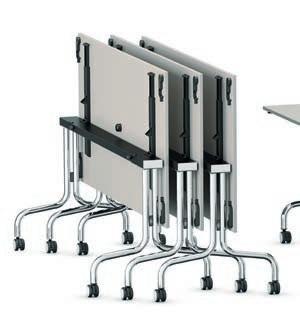
All FlipTables have a foldable top, so the tables can be nested together.
FLIPTABLE
All FlipTables are available in standing and sitting heights.
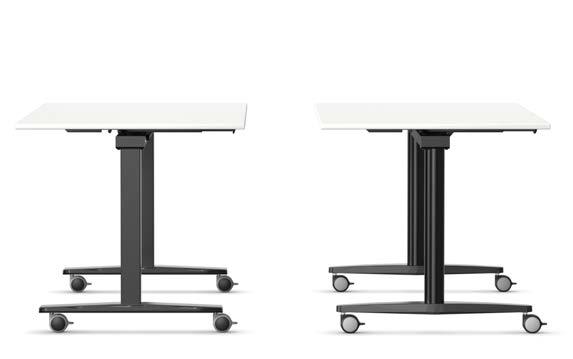
The FlipTables are fully mobile on 4 lockable castors and available in 3 distinct frames: RU, TQ, and TR.
The RU frame is made from 2 bent steel tubes, the TQ frame consists of a T-foot square steel tube column, and the TR frame consists of a T-foot round steel tube column. All 3 frames have a centrally positioned tubular-steel crosspiece with an articulated bracket.
FlipTables can be ordered with a writable surface
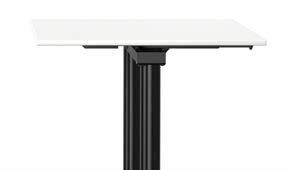
tabletop, creating an additional active space for students to interact with and even present their work in a group setting.
Planning Tip: Incorporate tables with folding tops in CTE spaces to effortlessly rearrange environments for large groups, guest speakers, and extensive project work. Their versatile design accommodates various group sizes and activities, while the large work surfaces support hands-on tasks and collaborative projects, enhancing the overall functionality of the learning environment.
RU
TQ TR
Comfortable foot rail on all 3 sides.
Available with phenolic (HPL) tops.
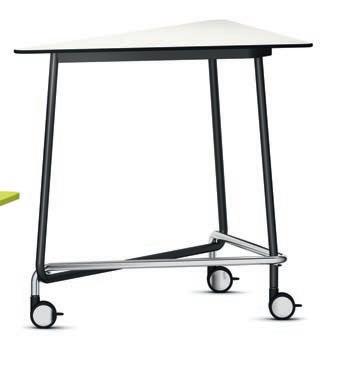
TRIUNION
The LiteTable-ST is stackable up to 8 and is equipped with stacking protection.
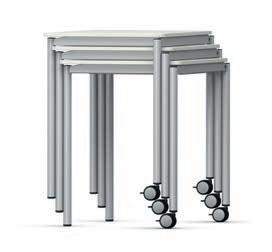
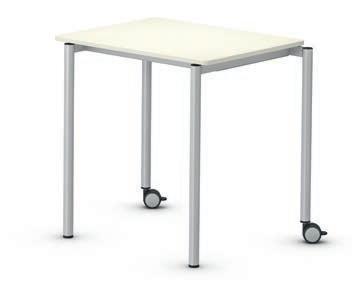
LITETABLE-ST
The TriUnion mobile standing table supports students and teachers in a multitude of learning situations and is built to be light but exceptionally stable, making it well equipped for everyday demands. Its triangular shape invites people into the conversation and brings small groups together quickly. Individual tables can also be combined for different group sizes.
Thanks to its castors it can easily be pushed, and it fits through any door wider than 35 ½ inches, so it can be used across different classes.
Planning Tip: Incorporate standing tables to enhance flexibility and well-being in educational spaces – their mobility and ergonomic design support diverse learning configurations and working postures, improving comfort and efficiency for both students and teachers.
The LiteTable-ST is made from welded round steel legs with a rectangular steel top frame, all powdercoated. It’s available in 7 heights so each student can find their perfect fit, and the tables are easily stackable. The LiteTable-ST has uniquely spaced table legs so the tables can be lined up against each other to form a continuous row without gaps in between.
Planning Tip: Integrate stackable tables for easy reconfiguration to suit various activities and group sizes, creating a seamless and adaptable workspace ideal for dynamic, project-based environments.
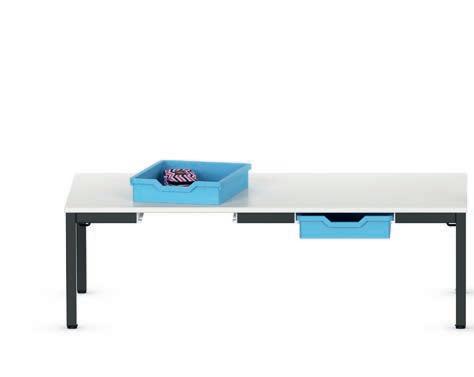
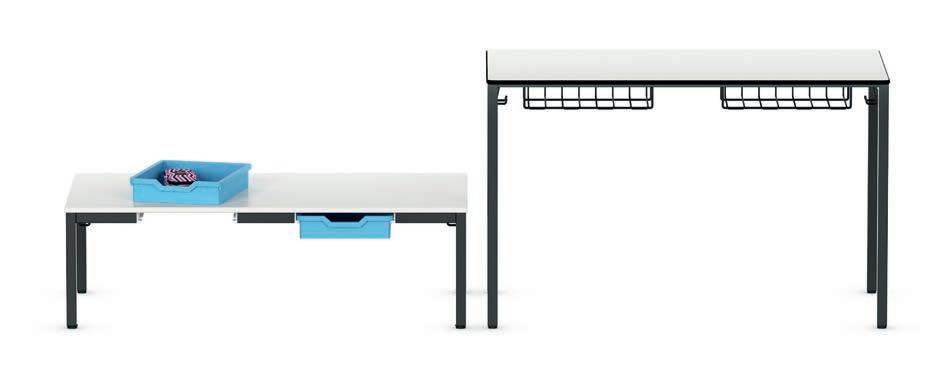
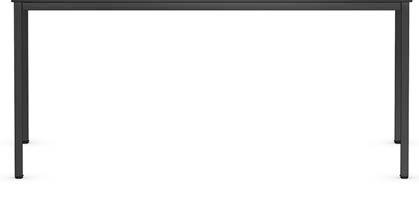
ECOTABLE
Timeless design, durability, and flexibility at budget-friendly prices make the EcoTable the quintessential multipurpose table. A smart choice for classrooms, media rooms, computer labs, as well as administration areas.
With their fully welded frame, the EcoTable-R and EcoTable-Q ranges of tables are designed to offer outstanding durability and stability. The welded table legs made from round tubular steel (EcoTable-R) or square tubular steel (EcoTable-Q) can be powdercoated in a variety of colors. The tables are available in square, rectangular, trapezoidal, or semicircular shapes.
Planning Tip: Integrate tables with durable work surfaces and welded frames into CTE programs to accommodate diverse activities, such as hands-on technical tasks, collaborative design work, and detailed projects in areas like engineering, cosmetology, and more.
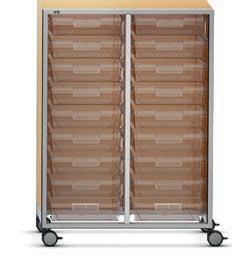
Available with phenolic (HPL) tops.
SpaceWalk fits under 47 1/4” height.
Certain models available with tilting top and writable laminate.
Available with phenolic (HPL) tops.
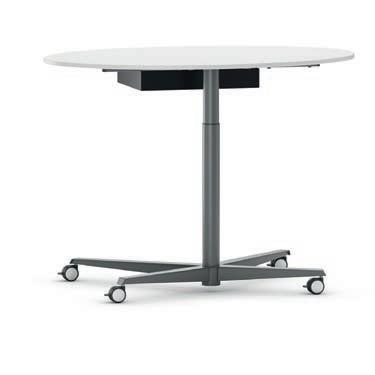
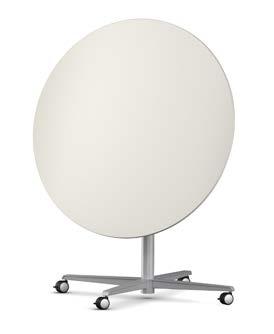
Continuously height adjustable via a hand switch on the tabletop edge.
Available with phenolic (HPL) tops.
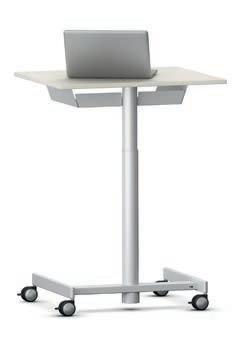
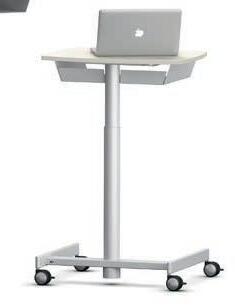
RONDOLIFT
The RondoLift table raises the bar for all ages with its fully adjustable tabletop that offers sit-at or stand-at functionality. The RondoLift-R features a round tube column, while the RondoLift-Q has a square tube column, providing different design options to suit various preferences. Lockable castors make it mobile, and the optional tilt mechanism on certain models allows it to be stowed in a snap or converted to a projection or display surface. Quick, creative options that help take education up a notch.
Planning Tip: Use multipurpose tables with tilting tops to create instant presentation surfaces, ideal for demonstrations and collaborative sessions. This adaptability enhances CTE and STEM learning environments, meeting evolving educational needs.
SHIFT+ INTERACT
The Shift+ Interact is easily moved around the room, thanks to its 4 castors (2 of which are lockable). The compact work surface, available in 2 shapes, ensures unhindered mobility; the optionally integrated bookshelf does not impede freedom of movement. The table is continuously height adjustable, the desired height can be easily achieved using a hand switch on the tabletop edge. In the model with a square tabletop it is possible to add a modesty screen.
Planning Tip: Mobile tables with compact surfaces can serve as both lecterns for presentations and as tables when supplies are stored separately. This flexibility allows students and teachers to stay mobile and easily transition between rooms and activities as needed.
SEATING
VS provides seating solutions that are essential for optimizing CTE environments, combining flexibility with functional design to support hands-on learning and collaborative activities. In CTE programs, where students are involved in practical, skill-building exercises, seating must be adaptable to various tasks and facilitate movement. Our collection features ergonomic and flexible seating options such as stackable chairs and stools, mobile chairs, and height-adjustable options to ensure students can work comfortably and efficiently, whether engaged in group projects, individual tasks, or technical training. By accommodating different activities and promoting ease of movement, our seating solutions enhance the effectiveness of learning experiences.
Cradle to Cradle GREENGUARD BIFMA Level 3 Outdoor Use
Available in 4 stool heights.
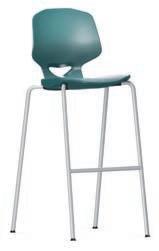
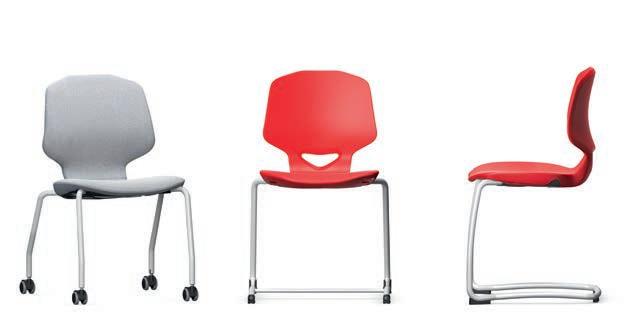
JUMPER
Adaptable and durable, the JUMPER chair is also active, lively, and versatile. Options for either an air-cushioned polypropylene or wooden seat shell are available. It comes in 6 sizes as a school chair and 2 sizes for office use, with multiple frame variants and a variety of color choices.
This highly flexible chair is designed for active sitting anywhere – classrooms, labs, cafeterias, libraries, offices, conference rooms, and more. The ergonomic shape and features help maintain correct back posture, while encouraging natural body movement – improving alertness, concentration, and well-being.
Planning Tip: Use chairs that support correct posture and natural movement to enhance focus and comfort, boosting student engagement and productivity during individual and collaborative activities.
Continuously height adjustable.
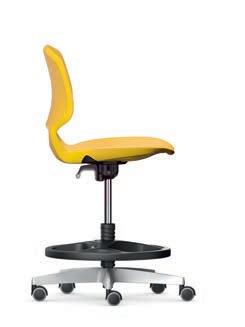
3D rocking mechanism available on all Moves.
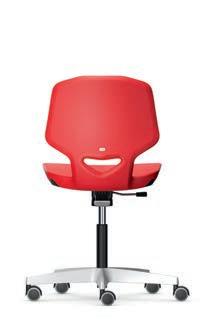
Can be stacked 10 high.
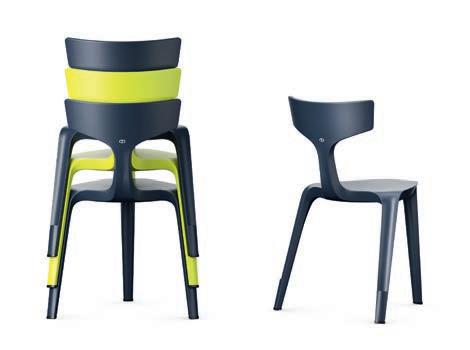
VS STAKKI
Gas spring height adjustment with anti-twist protector results in overall stability and comfort.
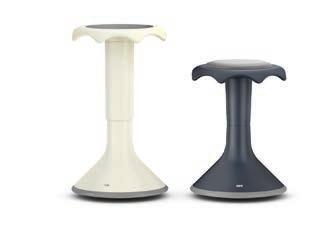
HOKKI
Scalloped edge allows for an innovative hang-on desk feature.
The VS Stakki is lightweight, easy to clean, stackable up to 10, and practical for indoor and outdoor use in educational environments. Designed with sustainability in mind, it’s made from a single part and consists of 100% recycled material.
Made from stable, durable, and extremely scratchresistant glass-fiber reinforced polypropylene, the VS Stakki weighs less than 9 pounds yet provides excellent stability. It accommodates various seating positions – front, side, back, or angled – making it a versatile and robust choice for diverse learning settings.
Planning Tip: Lightweight, stackable chairs are crucial for flexible space setup, quick reconfiguration, and handling various group sizes, both indoors and outdoors.
The Hokki wobble stool by VS is a true original, with an innovative design that allows you to easily and safely move without tipping over. Engineered for incredible stability, the Hokki wobble stool is very safe to use.
The Hokki+ is the height-adjustable Hokki. It has a gas spring height adjustment with anti-twist protector, resulting in overall stability and seating comfort. The adjustment mechanism is immediately accessible and can be triggered from any position.
Planning Tip: Use dynamically designed stools in areas where students switch between tasks, engage in hands-on projects, and collaborate with peers, ensuring comfort and effective participation.
Continuously height adjustable.
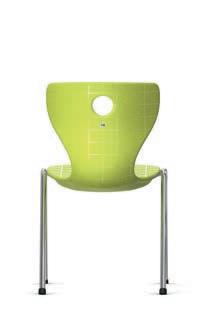
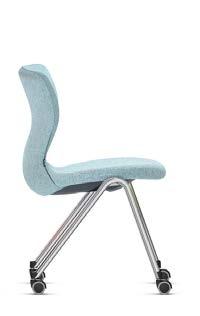
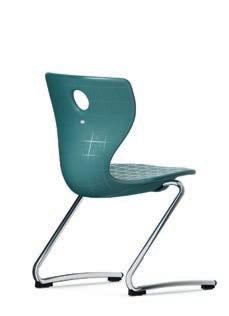
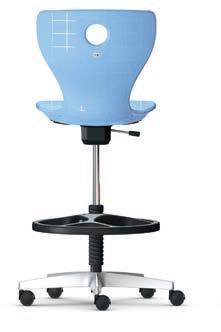
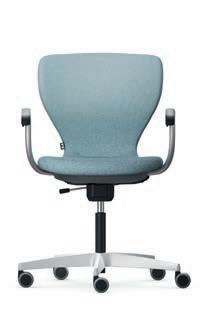
PANTO
The Panto line of chairs – including the PantoSwing, PantoMove, and Compass – remains an industry leader and a staple in modern classrooms, prioritizing physical well-being and mental agility with ergonomic construction, curated materials, and distinctive design.
Available with either an air-cushioned polypropylene or wooden seat shell, the iconic chairs come in 6 sizes for schools and 2 sizes for office use, with multiple frame variants and a wide range of color options. Whatever your needs, the ergonomic Panto chairs offer versatile seating solutions with forward-flexing materials that encourage natural movement and ensure comfort in any educational setting.
Planning Tip: Ergonomic seating supports hands-on activities and collaboration, fostering environments that enhance authentic learning experiences, reflect realworld scenarios, and maximize student involvement and skill development.
3D rocking mechanism available on all Moves.
Piggy-back design for easy tabletop storage.
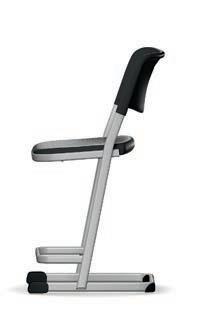
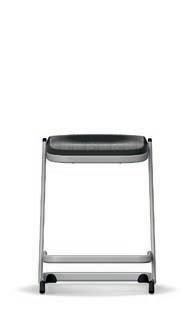
LUPOSTOOL
Versatile and stackable, the LuPoStool comes in 3 heights and features a comfortable polypropylene air-cushioned seat, optional backrest, and glides. The skid stool’s piggy-back design allows for easy tabletop storage.
The smallest model comes without a footrest, while the middle and larger models include one. With various fixed heights to suit different workstations and durable construction, the LuPoStool’s design keeps lab spaces organized and clutter-free.
Planning Tip: When planning CTE labs, especially in wet, messy, or construction areas, incorporate stackable stools to maintain a versatile and organized workspace, enhancing lab functionality and safety.
4 foot rings are positioned at different heights for use as footrests.
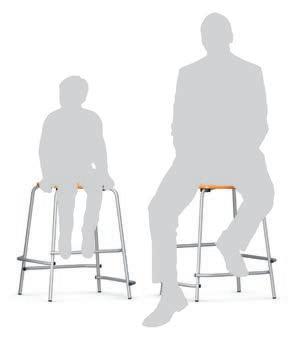
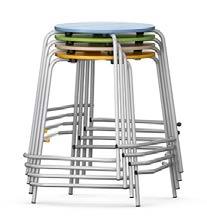
SOLO
The Solo stool is a multipurpose seating solution for design and build programs like robotics and biomedical labs. It is stackable up to 4 and available in 5 fixed heights, with 4 foot rings positioned at different levels to serve as footrests, accommodating students of all sizes. The wide seat pan is free of rivets, preventing it from catching on clothing.
Planning Tip: Use stools with varying height foot rings to accommodate students of all ages and sizes, ensuring comfort and flexibility.
TABLETOPS
VS offers a wide range of tabletops designed to meet the needs of any learning environment, including phenolic (HPL) and chipboard laminated (CPL) options. Each tabletop is crafted to provide long-lasting performance, ensuring versatility and durability for different applications, from classrooms to labs.
Optional built-in socket
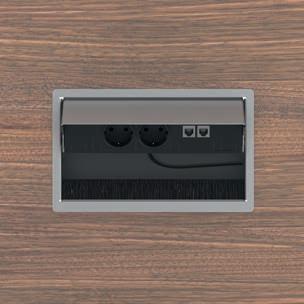
Electrical connection variant with cable suspension
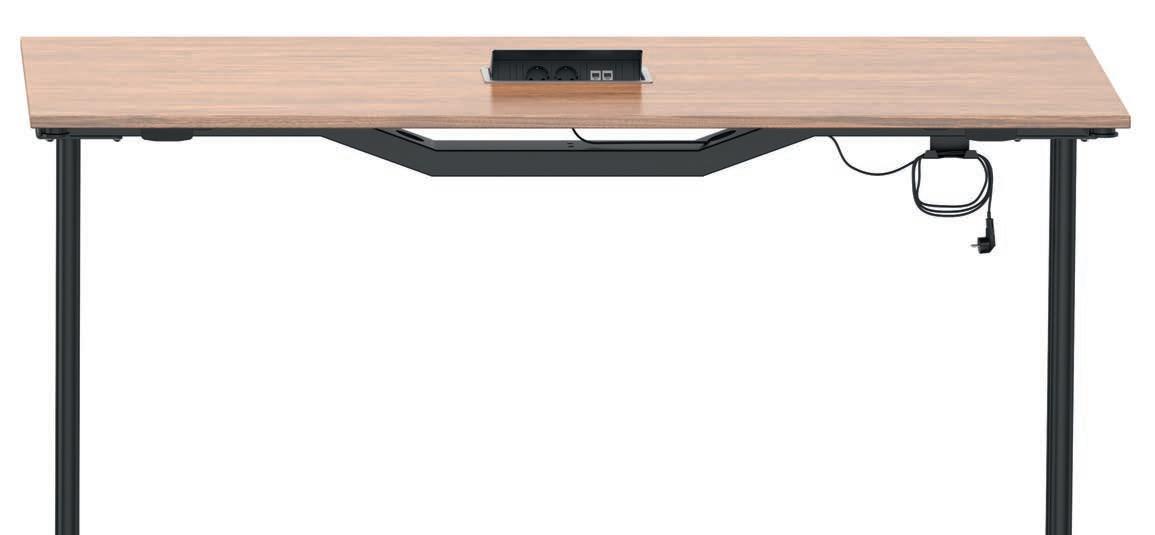
Some tables can be equipped with a bent frame to allow for an electrical connection.
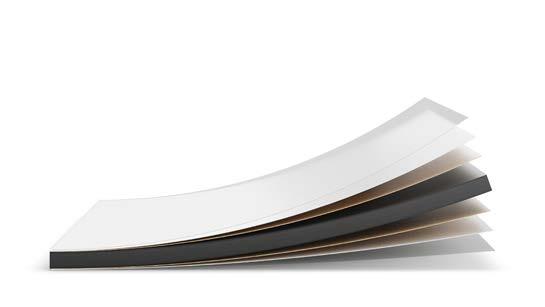
Phenolic (HPL)
Phenolic (HPL) is a premium, engineered material crafted from layers of phenolic resin-impregnated kraft paper, topped with a decorative surface and thermally fused under high pressure. This results in a highly durable, resilient, and visually appealing panel ideal for various applications, particularly in demanding environments like K-12 education settings.
Edge: Exposed core rounded edge (black) Thickness: 0.55”
Exceptional Durability: Phenolic (HPL) is renowned for its superior resistance to wear, impact, and scratching, ensuring longevity even in high-traffic areas.
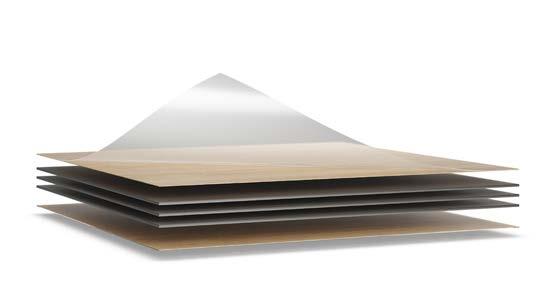
Chipboard Laminated (CPL)
CPL surfaces are made from high-quality, multidensity particle boards laminated with decorative surfaces. The laminates are constructed from layers of kraft paper and decorative paper impregnated with heat-hardening resins along with an overlay material. The layers are fused together under high heat and pressure to ensure a consistent and durable finish.
Moisture Resistance: The non-porous surface is designed to resist water, making it easy to clean and maintain.
Heat and Fire Resistance: Engineered to withstand high temperatures, phenolic (HPL) is suitable for use in environments where heat exposure is common, adding an extra layer of safety.
Recommended Applications:
Classroom desks and tables
STEM, makerspace, science, and art room work surfaces
Cafeteria and dining tables
Collaborative workspaces
Library and study tables
Multipurpose room tables
PHENOLIC (HPL) + CHEMICAL RESISTANCE
We offer a selection of laminates from the Fundermax Max Resistance collection, known for its resistance to harsh chemicals used in laboratory environments. Please contact your local VS Territory Manager for more information and pricing.
Edge: 0.1” plastic edge
Top Thickness: 0.75”
Superior Scratch and Impact Resistance: Built to endure the demanding conditions of educational settings, CPL surfaces maintain their appearance despite daily use by students and staff in hightraffic areas.
Design Versatility: Available in a wide array of shapes and sizes.
Cost-Effective: CPL is an economical choice without compromising on quality.
Recommended Applications:
Classroom desks and tables
Collaborative workspaces
Library and study tables
Teacher desks and administrative office furniture
Multipurpose room tables
Important note: Not all products are available in all colors –ask your VS Territory Manager for more information.
COLORS & MATERIALS








































































Plastic colors
Wood stain colors
Metal colors
Laminate colors (tables and storage)
Veneer colors







Additional laminate colors (storage doors only)












051 polar white 045 broom yellow
091 white 060 chromeplated
084 oxblood
412 light blue 413 light green
315 orange
S255 grey S257 grey blue
S254 anthracite
S261 blue S262 turquoise
S259 red
978 brown grey
319 dark red 318 green
340 natural oak 415 terra grey
SUSTAINABILITY
Over a century of sustainability and craft.
For the last 125 years, VS has been providing outstanding educational furniture that brings visionary design concepts into the places we learn, work, and play. Although much has changed in the industry over the decades, our fundamentals stay the same. Our long-standing commitment to sustainability and quality craftsmanship remains our mission at VS.
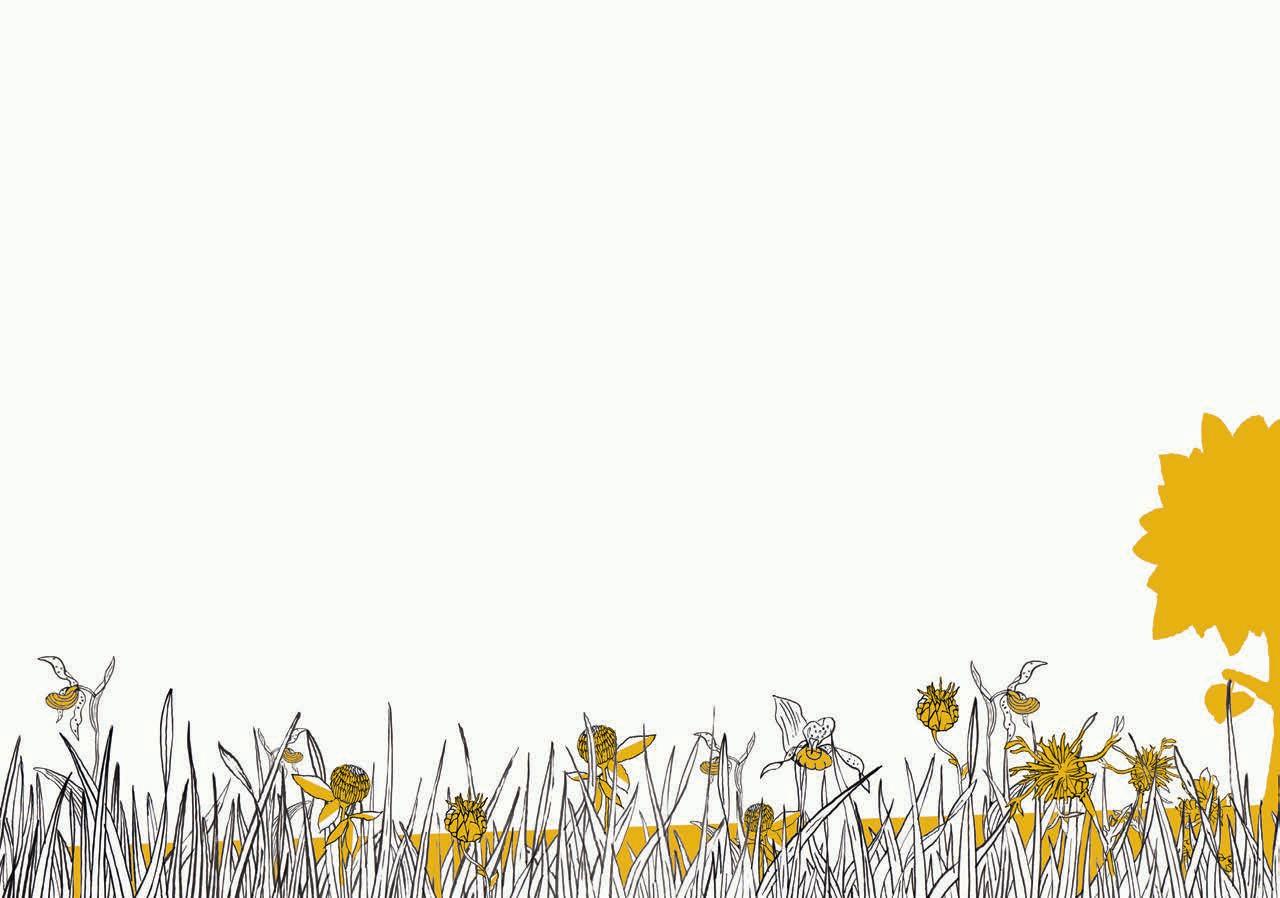
As a company, we have always considered it our responsibility to commit to measures that benefit people, while protecting the natural environment. We offer our customers safe, healthy, long-life products, all manufactured in a way that contributes to environmental protection.
Product certifications include:
Cradle to Cradle GREENGUARD BIFMA Level 3
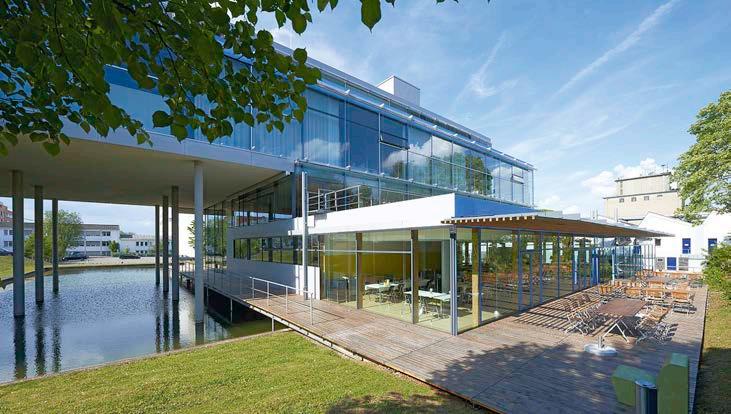
VS headquarters, designed by Behnisch Architekten, utilizes high-performance building and design strategies.
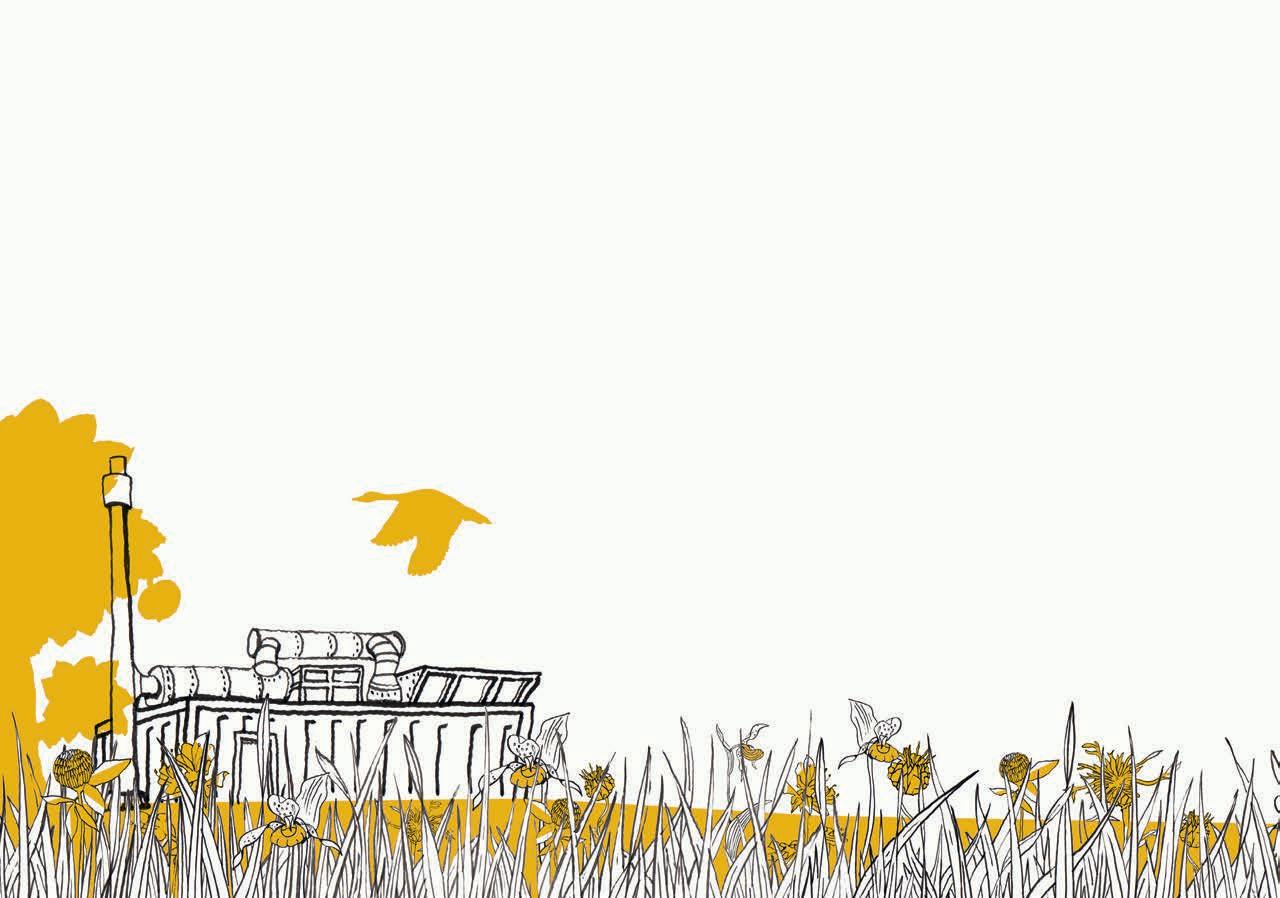
We deliberately control our energy consumption by keeping well below the permitted limit values in our new building projects, continuously improving our energy performance. Our gas-fired cogeneration plant covers 36 percent of our electricity consumption and also provides us with additional heating energy.
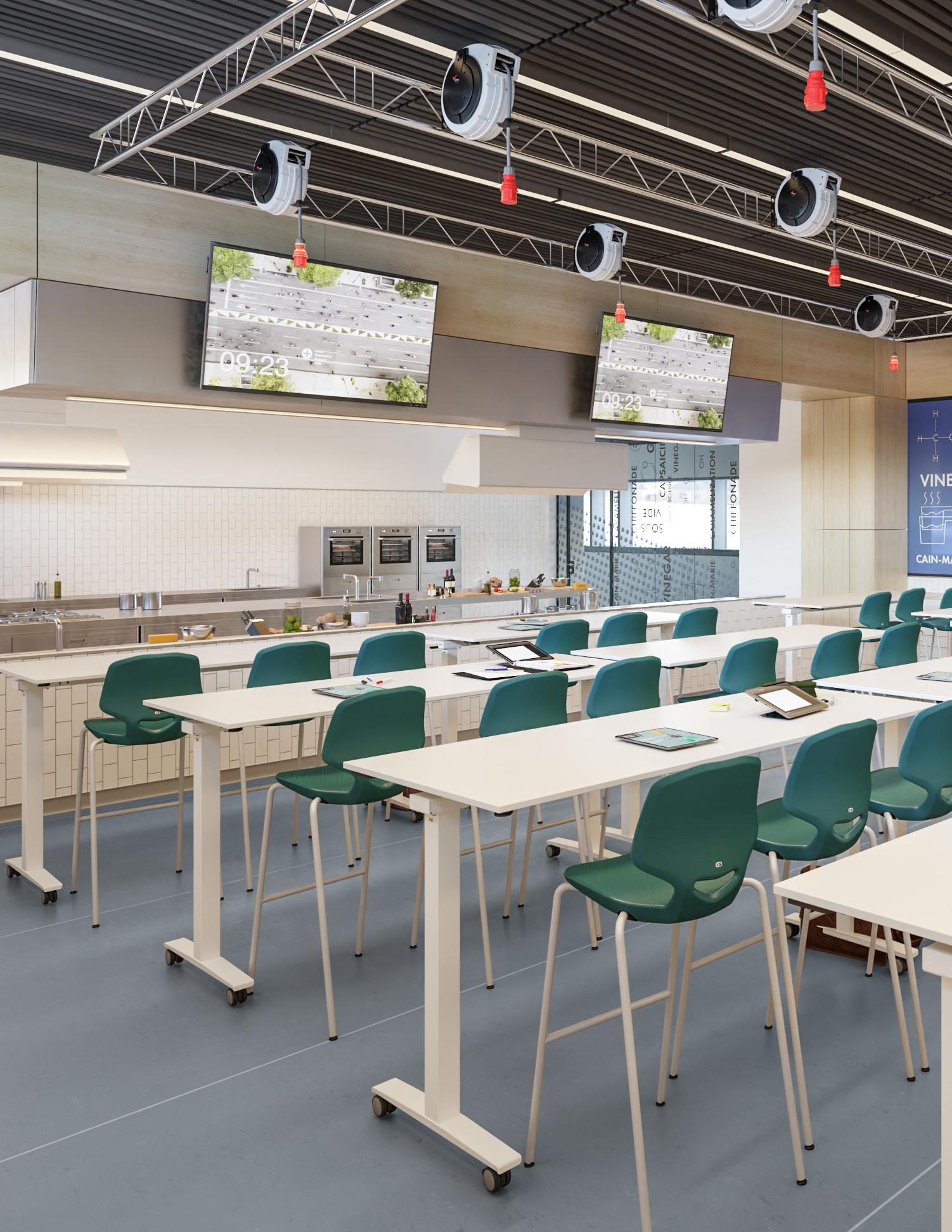
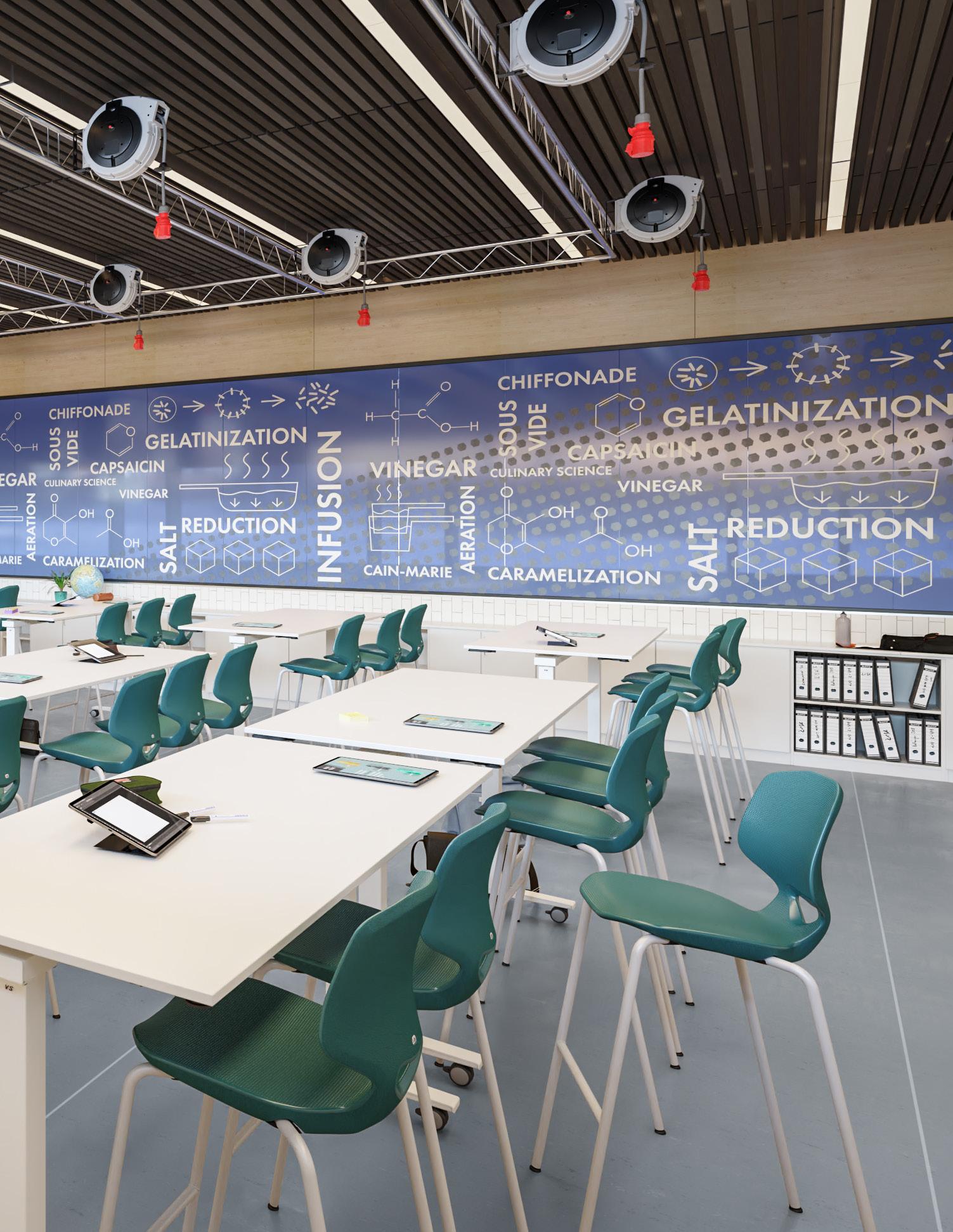
SOURCES
Fordham Institute (2024)
Career and Technical Education in High School: Does It Improve Student Outcomes?
Authors: Shaun M. Dougherty, Michael J. Petrilli, Dara
Zeehandelaar Shaw, Ph.D.
Publication Date: 2024
Advance CTE (2023)
Work-Based Learning: State Policies and Practices
Authors: Various authors from Advance CTE
Publication Date: 2023
CTE Research Network (2024)
Building Robust District Work-Based Learning Data Collection Systems
Authors: Jim Lindsay, Katherine Hughes, Shaun M. Dougherty, Kelly Reese, and Megha Joshi
Publication Date: March 2024
Advance CTE (2023)
The State of CTE: Work-Based Learning in Perkins V State Plans
Authors: Christina Koch, Policy Associate; Tom Keily, Senior Policy Analyst
Publication Date: January 27, 2021
